Documents: Go to download!
User Manual
- User Manual - (English)
- Specification Sheet - (English)
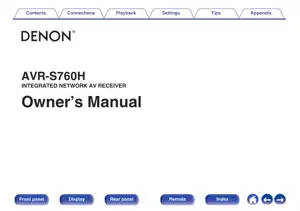
- Inserting the batteries
- Operating range of the remote control unit
- Features
- Part names and functions
- Connections
- Basic operation
- Troubleshooting
- Resetting factory settings
- Resetting network settings
- Restoring the firmware to the factory defaults
Table of contents
Owner Guide INTEGRATED NETWORK AV RECEIVER
Inserting the batteries
- Remove the rear lid in the direction of the arrow and remove it.
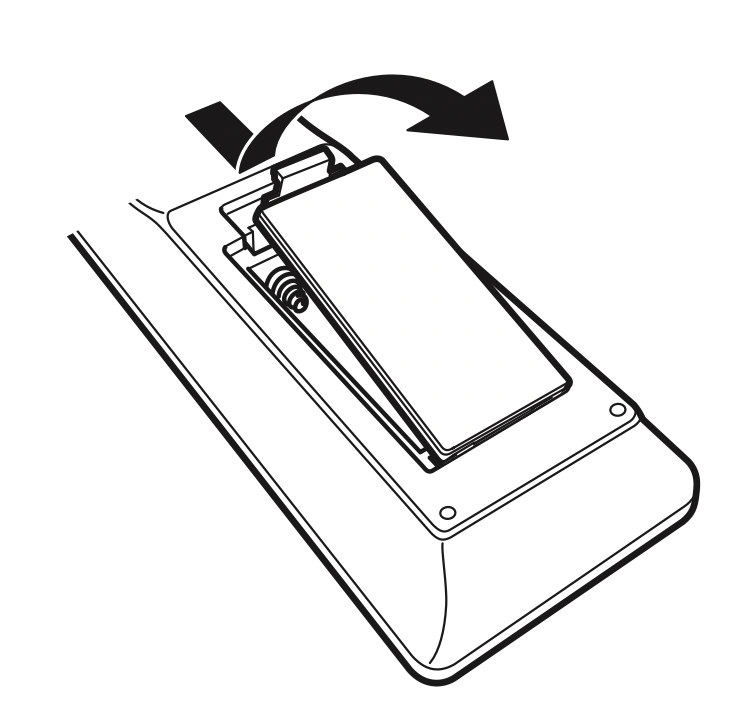
- Insert two batteries correctly into the battery compartment as indicated.
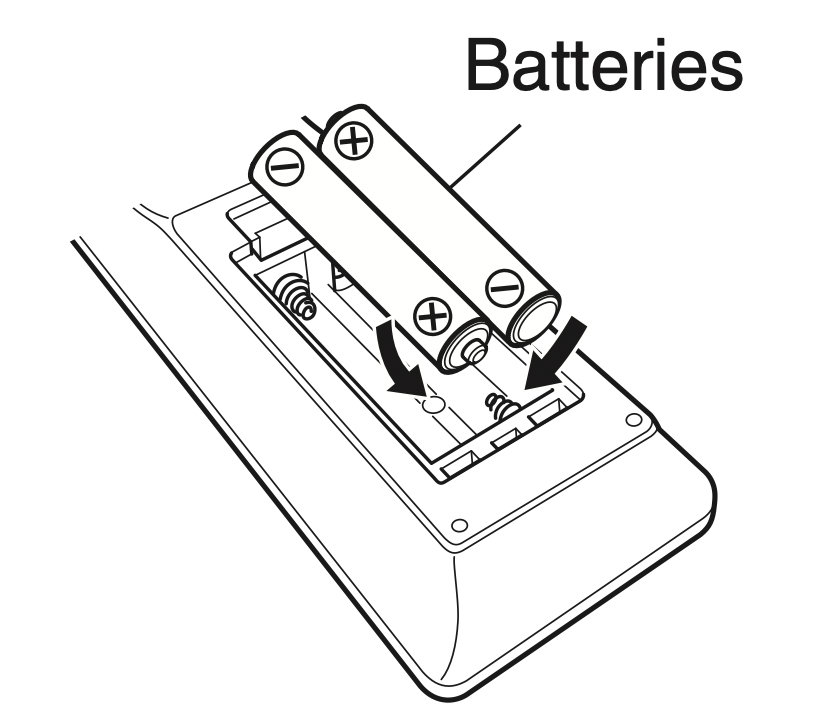
- Put the rear cover back on.
NOTE
- To prevent damage or leakage of battery fluid:
- Do not use a new battery together with an old one.
- Do not use two different types of batteries.
- Remove the batteries from the remote control unit if it will not be in use for long periods.
- If the battery fluid should leak, carefully wipe the fluid off the inside of the battery compartment and insert new batteries.
Operating range of the remote control unit
Point the remote control unit at the remote sensor when operating it.

Features
High quality sound
- With discrete circuit technology, the power amplifier provides identical quality for all 7-channels (110 Watts x 7-channels)
For optimum realism and stunning dynamic range, the power amplifier section features discrete power devices (not integrated circuitry).
By using high current, high power discrete power devices, the amplifier is able to easily drive high quality speakers. - Dolby Atmos (p. 260)
This unit is equipped with a decoder that supports Dolby Atmos audio format. The placement or movement of sound is accurately reproduced by the addition of overhead speakers, enabling you to experience an incredibly natural and realistic surround sound field. - Speaker Virtualizer (p. 150)
See other models: DENON AVS-3 HDMI-SWITCH DENON AVS-3 - 3 IN/1 OUT HDMI SWITCHER AH-D9200 AH-D7200 AH-D5200
Speaker Virtualizer enables you to access a more immersive entertainment experience from traditional channel based speaker layouts through digital signal processing including Dolby Atmos height virtualization and surround virtualization.- Speaker Virtualizer is not for use when both height speakers and surround speakers are connected.
- Height Virtualization may be applied when surround speakers are connected.
- DTS:X (p. 264)
This unit is equipped with the DTS:X decoder technology. DTS:X brings the home theater experience to new heights with its immersive object based audio technology which removes the bounds of channels. The flexibility of objects allows for sound to be scaled large or small and moved around the room with greater accuracy than ever before leading to a richer immersive audio experience. - DTS Virtual:X (p. 264)
DTS Virtual:X technology features DTS’s proprietary virtual height and virtual surround processing to deliver an immersive sound experience from any type of input source (stereo to 7.1.4 channel) and speaker configuration.- DTS Virtual:X is not for use when Height speakers are connected.
High performance
- 8K 60Hz input/output supported

When 8K Ultra HD (High Definition) is used, an input/output speed of 60 frames per second (60p) is achieved for video signals. When connected to 8K Ultra HD and 60p video signal input compatible TV, you can enjoy the sense of realism only available from high-definition images, even when viewing fast-moving video.
This unit supports a wide range of HDR content, delivering even higher definition video. - HDCP 2.3
This unit is compatible with HDCP 2.3 copyright protection standard. - Digital video processor upscales HD (1080p) / 4K to 8K

This unit is equipped with a 8K video upscaling function that allows HD (High Definition) 1080p/4K video to be output via HDMI at 8K (7680 × 4320 pixels) resolution. This function enables the device to be connected to a TV using a single HDMI cable, and produces high definition images for any video source. - eARC (Enhanced Audio Return Channel) function compatibility
The eARC function is compatible with conventional ARC functioncompatible audio formats in addition to multichannel linear PCM, Dolby TrueHD, Dolby Atmos, DTS-HD Master Audio, DTS:X and other audio formats a conventional ARC function cannot transmit.
Additionally, connecting to an eARC function-compatible television enables enjoyment of higher-quality surround playback of the audio content played from your television. - HDMI connections enable connection to various digital AV devices (6 inputs, 1 output)
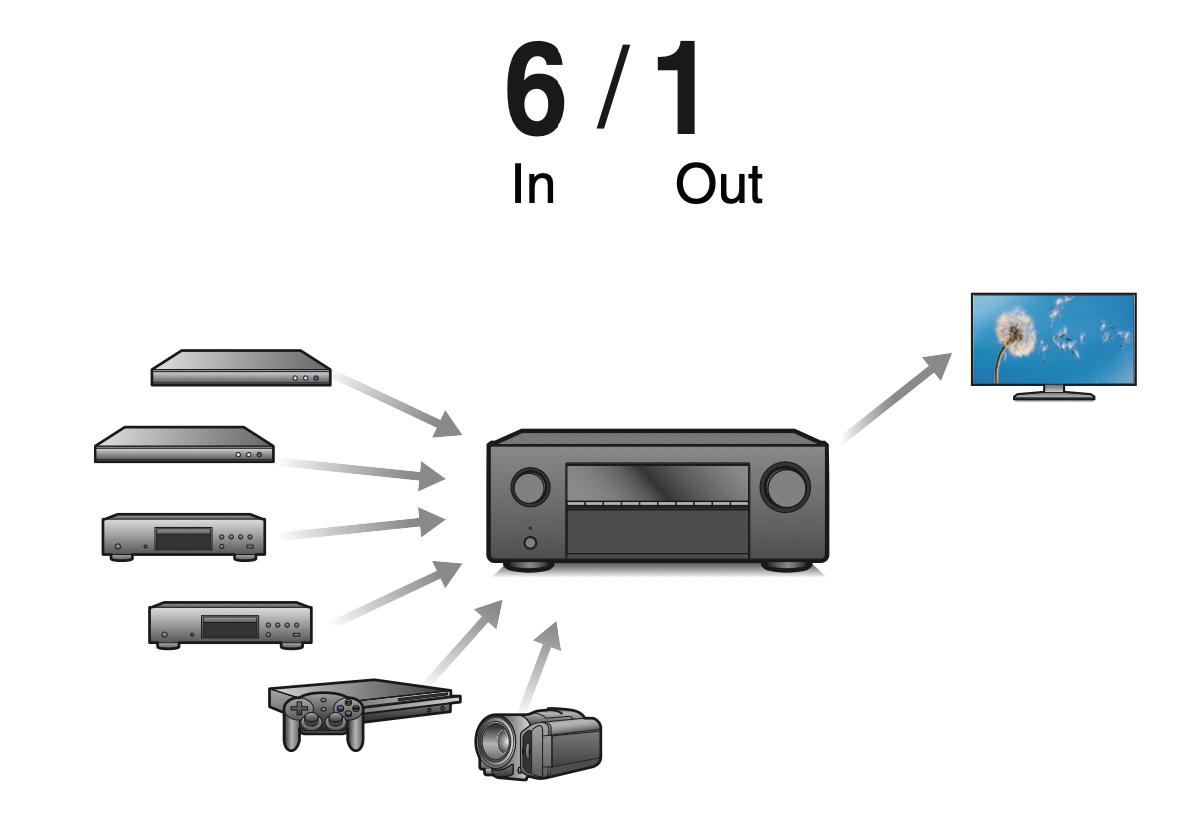
This unit is equipped with 6 HDMI inputs and 1 HDMI output enabling connection to various HDMI compatible devices such as Blu-ray Disc players, game consoles and HD video camcorders. - The device is equipped with a AirPlay ® function in addition to network functions such as Internet radio etc. (p. 101)
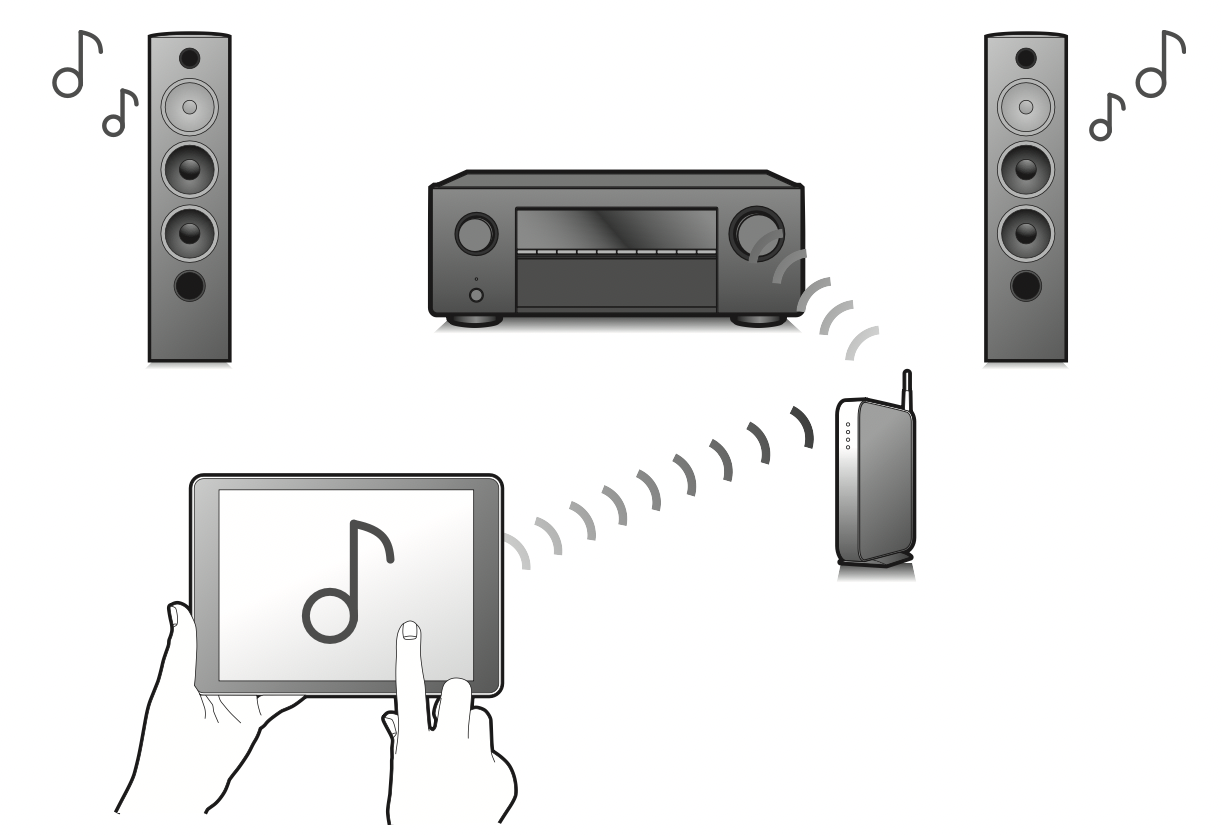
You can enjoy a wide variety of content, including listening to Internet Radio, playing audio files stored on your PC.
This unit also supports® Apple AirPlay which® lets you stream your music library from an iPhone , iPad® , iPod touch or iTunes ® . - Supports AirPlay 2 ® wireless audio
Sync multiple AirPlay 2 compatible devices/speakers for simultaneous playback.
This unit supports AirPlay 2 and requires iOS 11.4 or later. - Playback of DSD and FLAC files via USB and networks
This unit supports the playback of high resolution audio formats such as DSD (5.6 MHz) and FLAC 192 kHz files. It provides high quality playback of high resolution files. - Wireless connection with Bluetooth devices can be carried out easily (p. 71)

You can enjoy music simply by connecting wirelessly with your smartphone, tablet, PC, etc. - Connect Bluetooth headphones
This unit can transmit Bluetooth so you can enjoy audio wirelessly through your Bluetooth headphones.
Playback can be performed using connected speakers and Bluetooth headphones simultaneously, or only using Bluetooth headphones.

- Multi-Room audio (p. 112)

You can select and play back the respective inputs in MAIN ZONE and ZONE2.
In addition, when the All Zone Stereo function is used, the music being played back in MAIN ZONE can be enjoyed in all the zones at the same time. This is useful when you want to let the background music propagate throughout the whole house. - Energy-saving design
This unit is equipped with an ECO Mode function that allows you to enjoy music and movies while reducing the power consumption during use, and also an auto-standby function that automatically turns off the power supply when the unit is not in use. This helps reduce unnecessary power use. - Compatible with the “Denon 2016 AVR Remote” App z for performing basic operations of the unit with an iPad, iPhone or Android™ devices (Google, Amazon Kindle Fire)

Along with many new features, the graphics and user interface have been completely overhauled. The new app gives you full control of this unit as well as access to its setup menu for detailed adjustments from your phones or tablets. “Denon 2016 AVR Remote” App also gives you quick access to the receiver's status display, option menus, Denon Bluray Disc player control, and online owner's manual for your convenience.
* Download the appropriate “Denon 2016 AVR Remote” App for your iOS or Android devices. This unit needs to be connected to the same LAN or Wi-Fi (wireless LAN) network that the iPad, iPhone or Android™ is connected to. - HEOS provides streaming music from your favorite online music sources

HEOS wireless multi-room sound system that enables you to enjoy your favorite music anywhere and everywhere around your home. By utilizing your existing home network and the HEOS App (available for iOS, Android and Amazon devices), you can explore, browse, and play music from your own music library or from many online streaming music services.
When multiple products with HEOS Built-in are connected to the same network, they can be grouped to play the same music on all products simultaneously, or different music can be played on each one.
Easy operation
- “Setup Assistant” provides easy-to-follow setup instructions
First select the language when prompted. Then simply follow the instructions displayed on the TV screen to set up the speakers, network, etc. - Easy to use Graphical User Interface
This unit is equipped with a Graphical User Interface for improved operability.
Part names and functions
Front panel
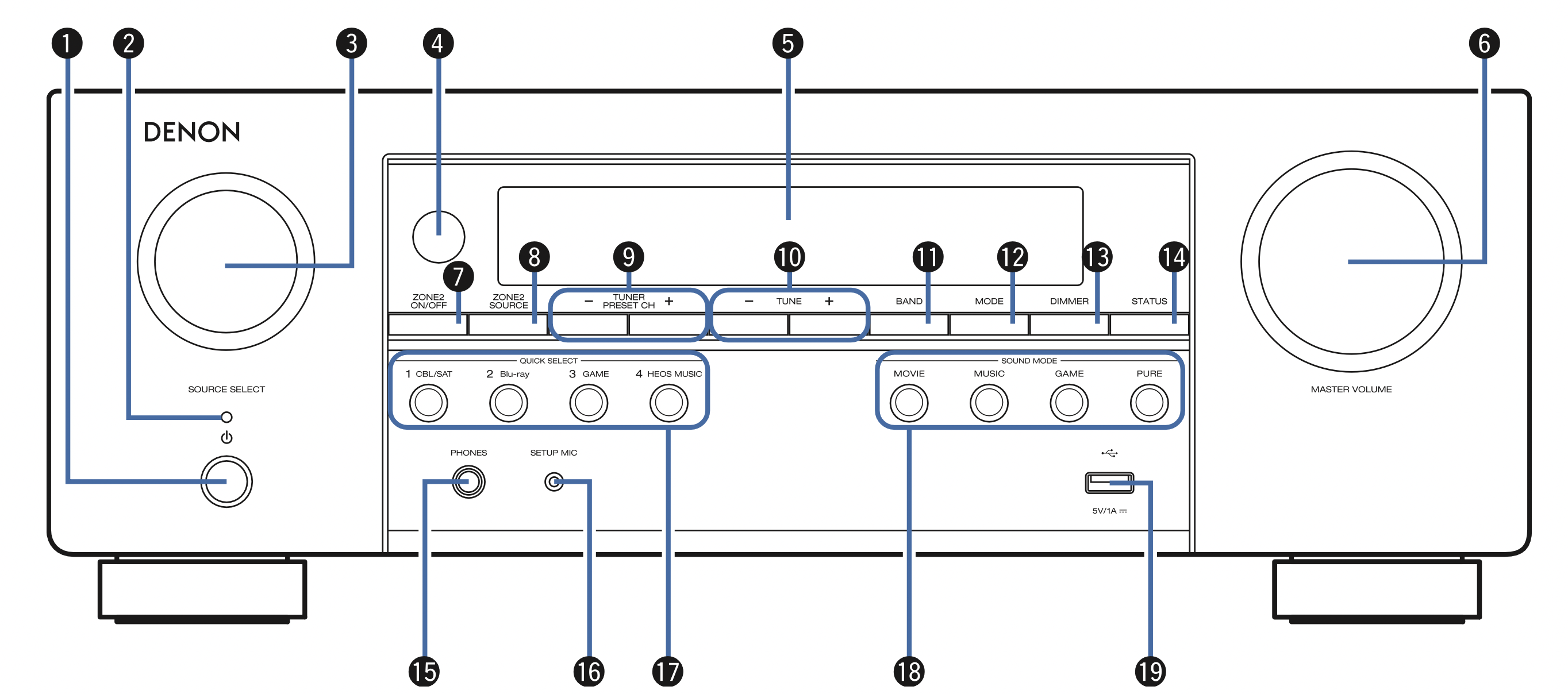
- Power operation button (
 )
)
Used to turn the power of the MAIN ZONE (room where this unit is located) on/off (standby). (v p. 65) - Power indicator
This is lit as follows according to the power status:
Green: Power on
Off: Normal standby
Red:
When “HDMI PassThrough” is set to “On” (p. 160)
When “HDMI Control” is set to “On” (p. 161)
When “Network Control” is set to “Always On” (p. 197) - SOURCE SELECT knob
This selects the input source. (p. 65) - Remote control sensor
This receives signals from the remote control unit. (p. 9) - Display
This displays various pieces of information. (p. 19) - MASTER VOLUME knob
This adjusts the volume level. (p. 66) - ZONE2 ON/OFF button
This turns the power of ZONE2 (another room) on/off. (p. 140) - ZONE2 SOURCE button
This selects the input source for ZONE2. (p. 140) - Tuner preset channel buttons (TUNER PRESET CH +, –)
These select preset broadcast stations. (p. 82) - Tuning up / Tuning down buttons (TUNE +, –)
Select either FM broadcast or AM broadcast. (p. 79) - Reception band select button (BAND)
This switches the reception band. (p. 79) - Tune mode select button (MODE)
This switches the tuning mode. (p. 81) - DIMMER button
Each press of this switches the brightness of the display. (p. 207) - STATUS button
Each press of this switches the status information that is shown on the display. - Headphones jack (PHONES)
This is used to connect headphones.
When the headphones are plugged into this jack, audio will no longer be output from the connected speakers or from the SUBWOOFER connectors.
NOTE: To prevent hearing loss, do not raise the volume level excessively when using headphones. - SETUP MIC jack
This is used to connect the supplied Sound calibration microphone. (p. 175) - QUICK SELECT buttons
With a single press of any of these buttons, you can call up various settings you’ve registered to each button such as the input source, volume level and sound mode settings. (p. 130) - SOUND MODE buttons
These select the sound mode. (p. 114) - USB port (
 )
)
This is used to connect USB storages (such as USB memory devices). (p. 58)
Display

- Input mode indicators
These light according to the audio input mode settings of each input source. (p. 170) - Surround back indicator
This lights when audio signals are being output from the surround back speakers. (p. 185) - Decoder indicators
These light when Dolby or DTS signals are input or when the Dolby or DTS decoder is running. - Audyssey ® indicator
This lights when “MultEQ ® ”, “Dynamic EQ” or “Dynamic Volume” has been set up. (p. 154) - Tuner reception mode indicators
These light up according to the reception conditions when the input source is set to “Tuner”.
TUNED: Lights up when the broadcast is properly tuned in.
STEREO: Lights up when receiving FM stereo broadcasts. - Sleep timer indicator
This lights when the sleep mode is selected. (p. 128) - Volume indicator
- MUTE indicator
This blinks while the sound is muted. (p. 66) - Information display
The input source name, sound mode, setting values and other information are displayed here. - Input signal indicators
The respective indicator will light corresponding to the input signal. (p. 170) - ZONE2 indicator
This lights up when ZONE2 (another room) power is turned on. (p. 140)
Rear panel
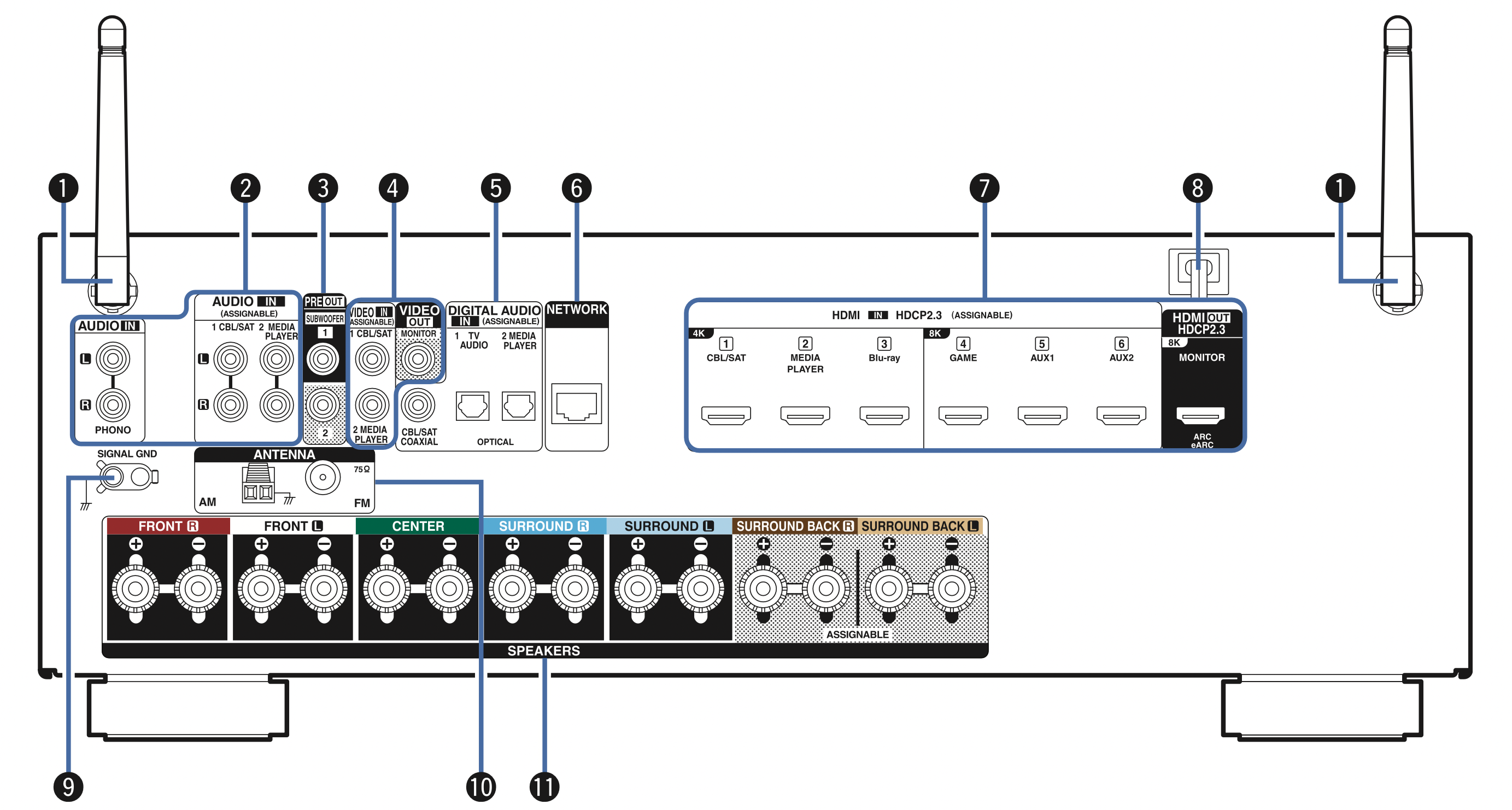
- Rod antennas for Bluetooth/wireless LAN
Stand this antenna upright when connecting to a network via wireless LAN, or when connecting to a handheld device via Bluetooth. (p. 62)

The antenna clip can be removed from the rear panel.
1. Rotate the antenna clip 90 degrees to the left.
2. Pull the antenna clip out towards yourself.
The antenna clip is needed when transporting this unit. Keep it in a safe place.
Attach the antenna clip by following the steps for removing it in reverse. - Analog audio connectors (AUDIO)
Used to connect devices equipped with analog audio connectors.
“Connecting a set-top box (Satellite tuner/cable TV)” (p. 53)
“Connecting a Blu-ray Disc player or DVD player” (p. 55)
“Connecting a turntable” (p. 57) - PRE OUT connectors
Used to connect a subwoofer with a built-in amplifier. (p. 36) - Video connectors (VIDEO)
Used to connect devices equipped with video connectors.
“Connection 3 : TV equipped without an HDMI connector” (p. 51)
“Connecting a set-top box (Satellite tuner/cable TV)” (p. 53) - Digital audio connectors (DIGITAL AUDIO)
Used to connect devices equipped with digital audio connectors.
“Connection 2 : TV equipped with an HDMI connector and incompatible with the ARC (Audio Return Channel) / eARC (Enhanced Audio Return Channel)” (p. 50)
“Connection 3 : TV equipped without an HDMI connector” (p. 51)
“Connecting a set-top box (Satellite tuner/cable TV)” (p. 53)
“Connecting a media player” (p. 54) - NETWORK connector
Used to connect to a LAN cable when connecting to a wired LAN network. (p. 61) - HDMI connectors
Used to connect devices equipped with HDMI connectors.
“Connection 1 : TV equipped with an HDMI connector and compatible with the ARC (Audio Return Channel) / eARC (Enhanced Audio Return Channel)” (p. 49)
“Connection 2 : TV equipped with an HDMI connector and incompatible with the ARC (Audio Return Channel) / eARC (Enhanced Audio Return Channel)” (p. 50)
“Connecting a set-top box (Satellite tuner/cable TV)” (p. 53)
“Connecting a Blu-ray Disc player or DVD player” (p. 55)
“Connecting a media player” (p. 54)
“Connecting a game console or player device compatible with the 8K” (p. 56) - Power cord (p. 63)
- SIGNAL GND terminal
Used to connect a ground wire for the turntable. (p. 57) - FM/AM antenna terminals (ANTENNA)
Used to connect FM antennas and AM loop antennas. (p. 59) - Speaker terminals (SPEAKERS)
Used to connect speakers. (p. 35)
NOTE: Do not touch the inner pins of the connectors on the rear panel. Electrostatic discharge may cause permanent damage to the unit.
Remote control unit



- ZONE SELECT buttons
These switch the zone (MAIN ZONE, ZONE2) that is operated through the remote control unit.
“Playback in ZONE2” (p. 140)
“Menu operations” (p. 146) - Input source select buttons
These selects the input source.
“Selecting the input source” (p. 65)
“Playback in ZONE2” (p. 140) - Channel/page search buttons (CH/PAGE
 )
)
These select radio stations registered to presets or switch pages. (p. 82) - MUTE button (
 )
)
This mutes the output audio.
“Turning off the sound temporarily (Muting)” (p. 66)
“Turning off the sound temporarily (Muting) (ZONE2)” (p. 141) - Information button (INFO)
This displays the status information on the TV screen. (p. 212) - Cursor buttons (
 )
)
These select items. - BACK button
This returns to the previous screen. - System buttons
These perform playback related operations.
Tuning up / Tuning down buttons (TUNE +, –)
These select either FM broadcast or AM broadcast. (p. 79) - QUICK SELECT buttons (1 – 4)
These call up settings registered to each button, such as input source, volume level and sound mode settings. (p. 130) - SOUND MODE buttons
These select the sound mode. (p. 114) - Remote control signal transmitter
This transmits signals from the remote control unit. (p. 9) - SLEEP button
This sets the sleep timer. (p. 128) - POWER button (
 )
)
This turns the power on/off.
“Turning the power on” (p. 65)
“Playback in ZONE2” (p. 140) - ECO Mode button (
 )
)
This switches to ECO Mode. (p. 201) - VOLUME buttons (
 )
)
These adjusts the volume level.
“Adjusting the volume” (p. 66)
“Adjusting the volume (ZONE2)” (p. 141) - OPTION button
This displays the option menu on the TV screen. - ENTER button
This determines the selection. - SETUP button
This displays the menu on the TV screen. (p. 146)
Connections
Speaker installation
Determine the speaker system depending on the number of speakers you are using and install each speaker and subwoofer in the room.
Speaker installation is explained using this example of a typical installation.
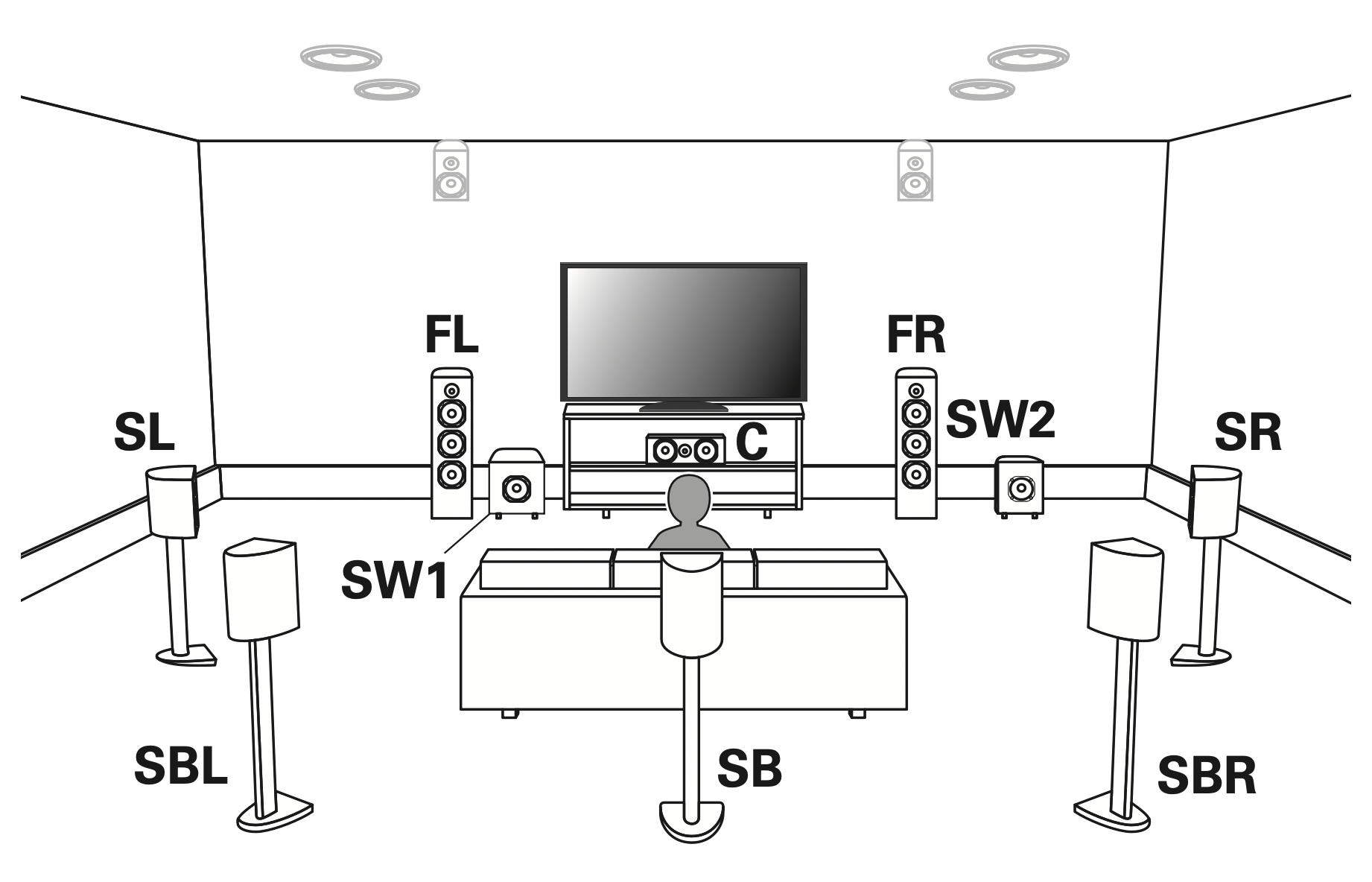

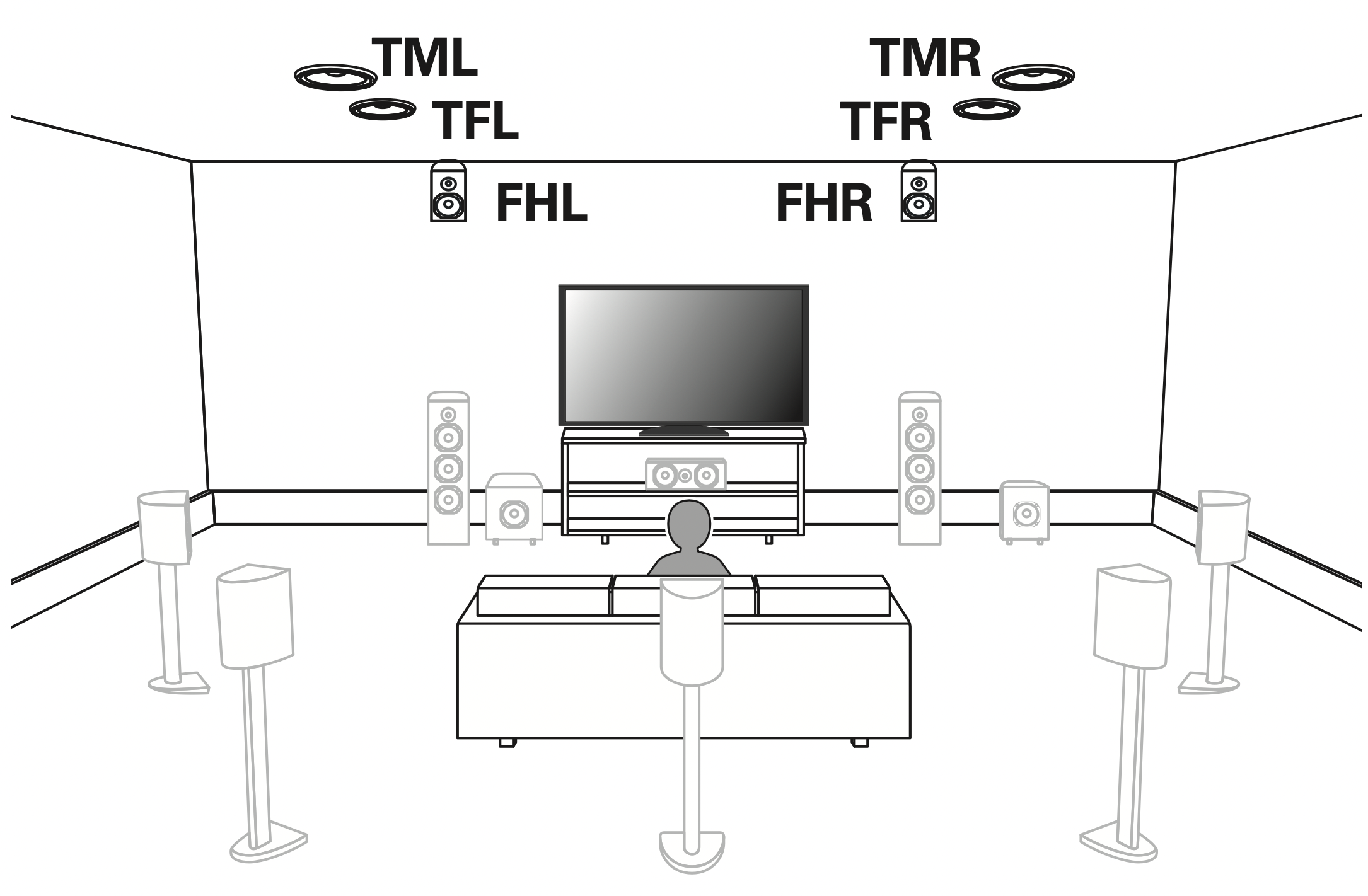
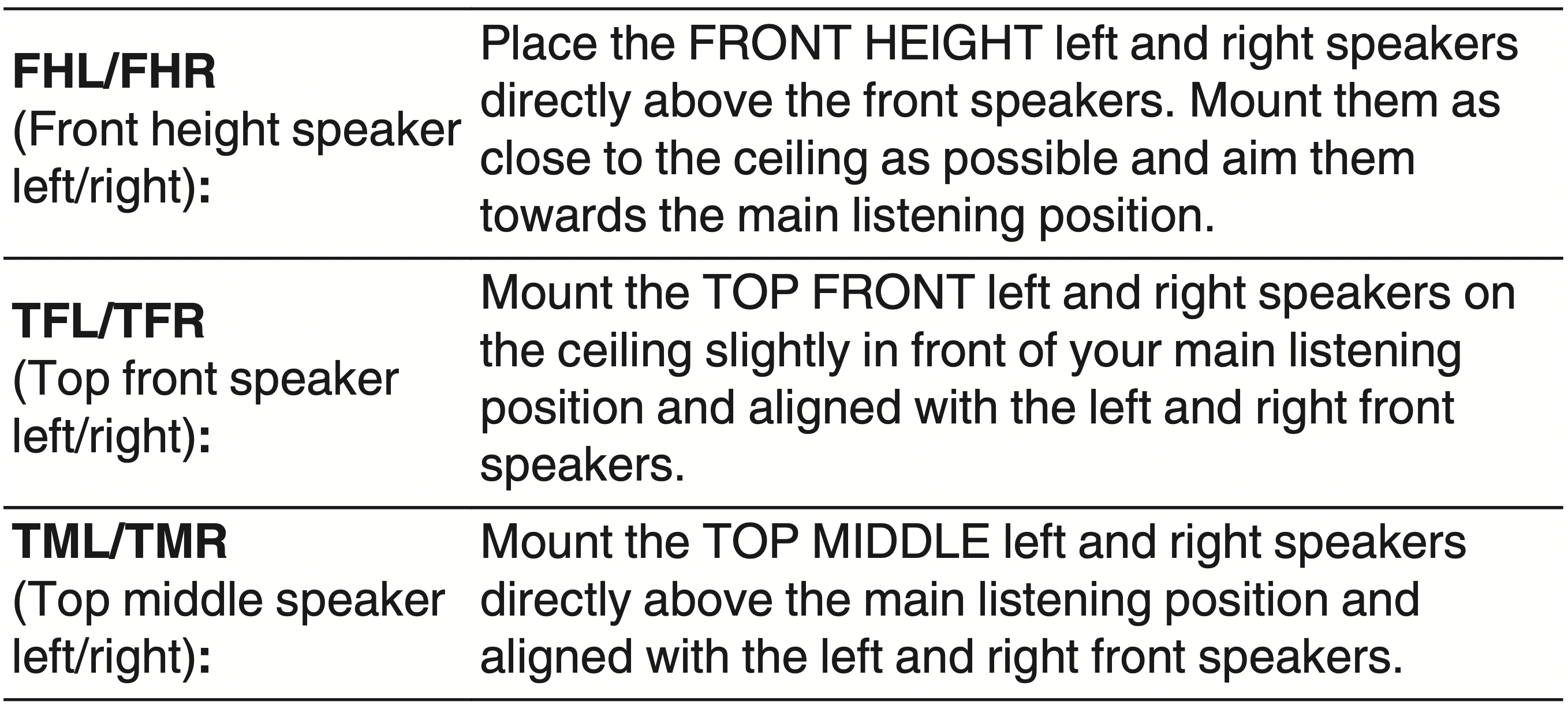
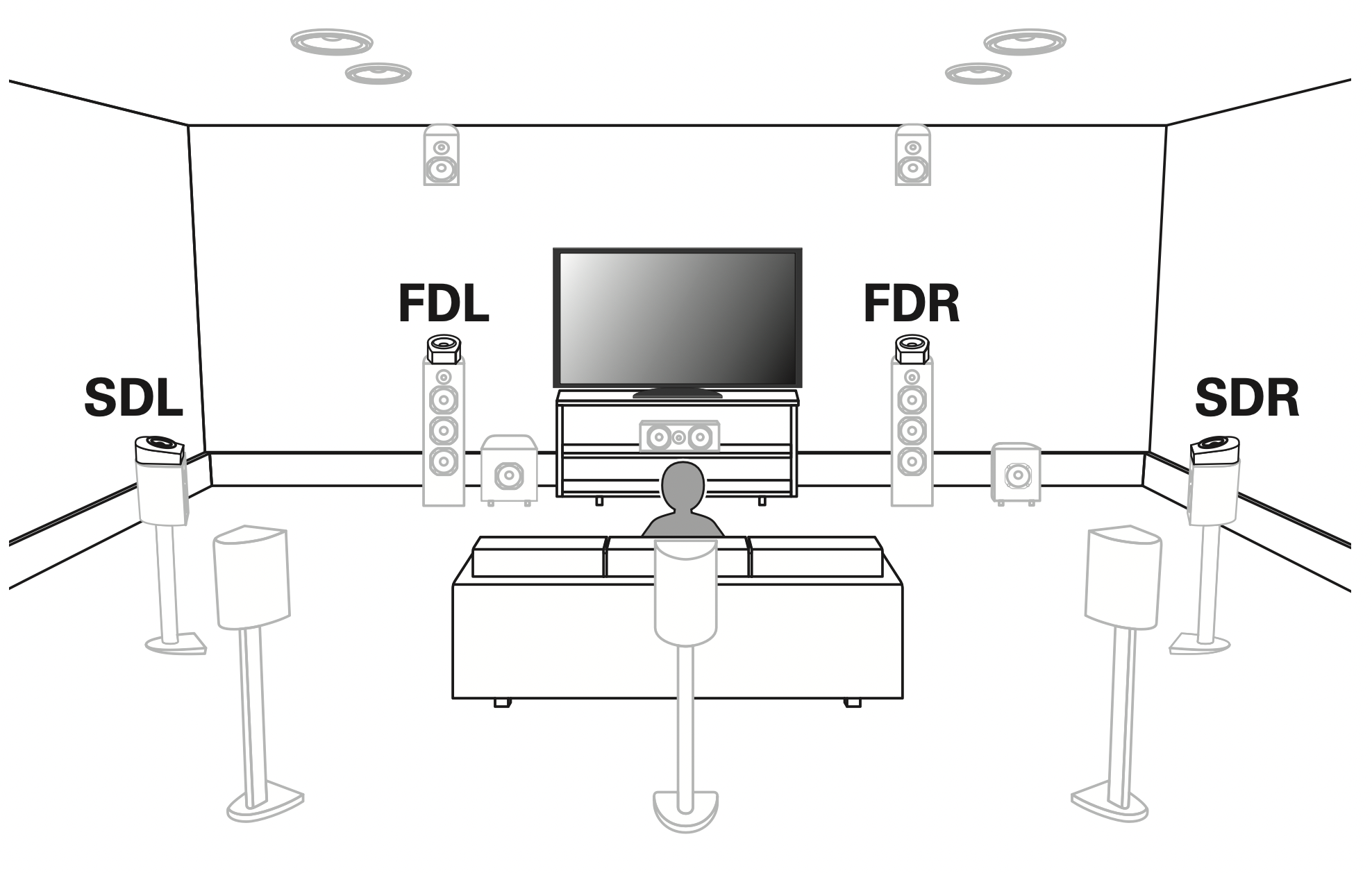
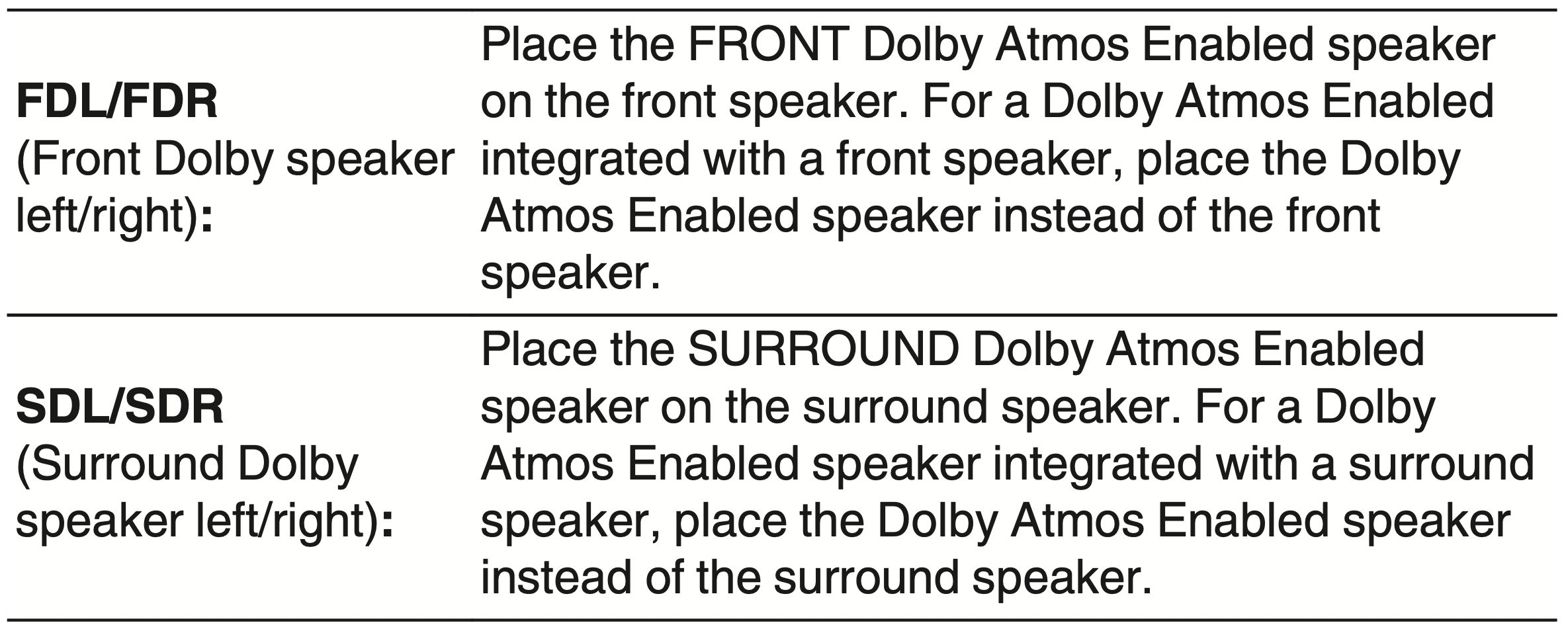
About Dolby Atmos Enabled speakers
Dolby Atmos Enabled speakers reflect the sound off the ceiling to allow the sound to come from over your head by using a special upwardpointing speaker that is placed on the floor.
You can enjoy the Dolby Atmos 3D sound even in an environment where speakers cannot be installed on the ceiling.

Note:
- This unit is compatible with Dolby Atmos and DTS:X which offers an even wider and deeper surround sensation.
- The “Sp.Virtualizer” must be set to “On” for Dolby Atmos playback with 5.1-channel speaker configurations or less. (p. 150) 0 DTS:X can be selected regardless of the speaker configuration.
- Use the illustration below as a guide for how high each speaker should be installed. The height does not need to be exactly the same.

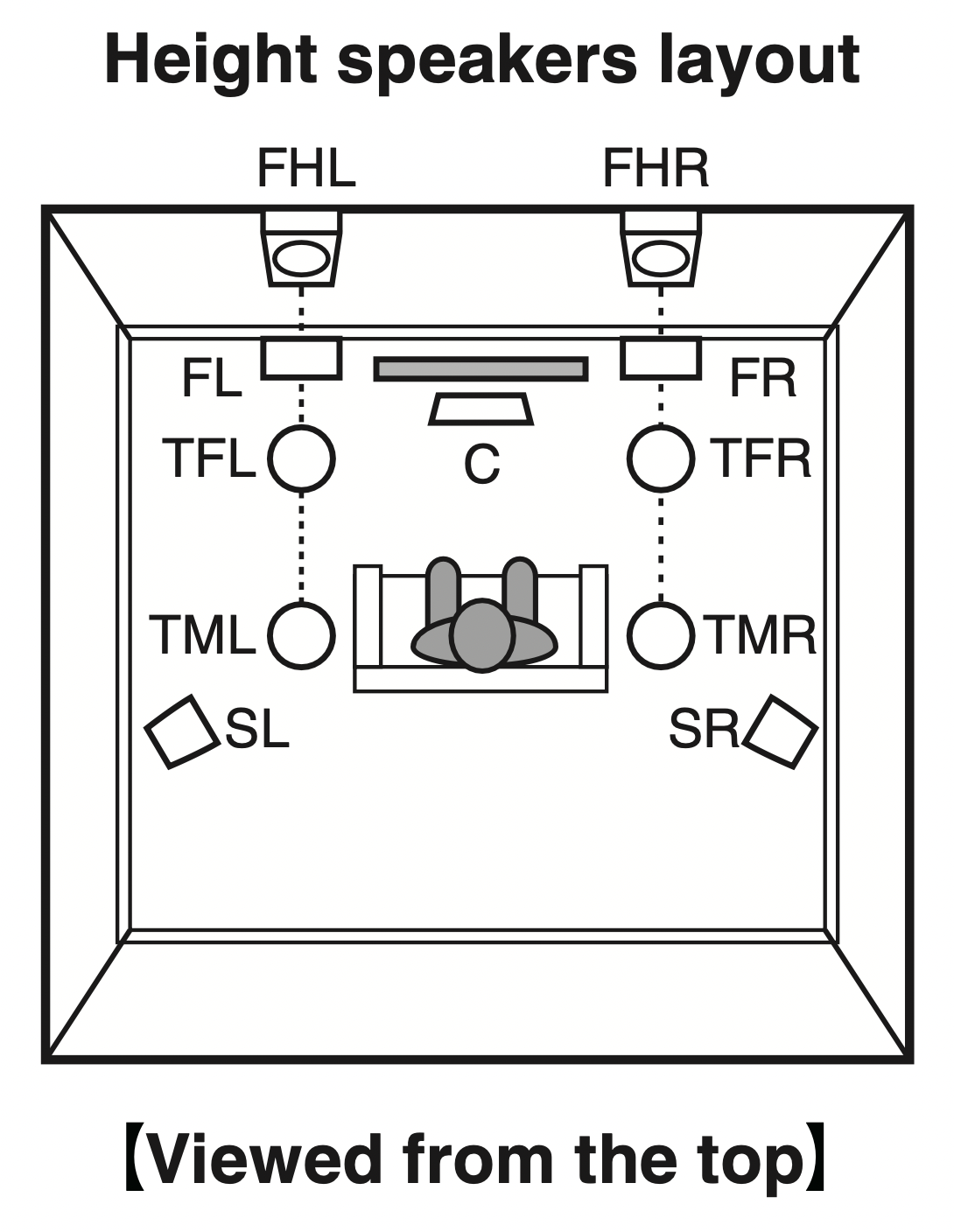
- When 7.1-channel speakers are installed using surround back speakers
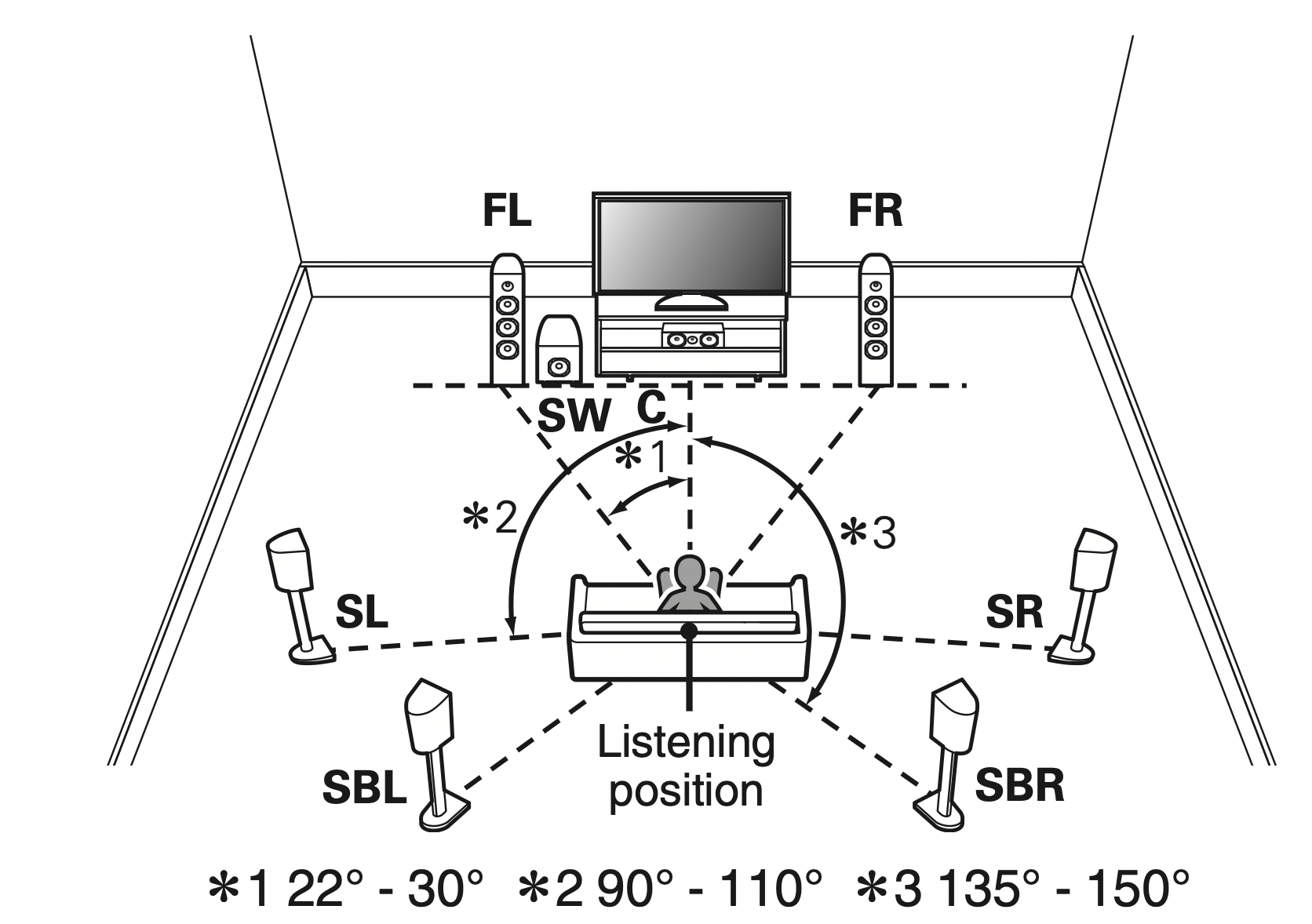
Note: When using a single surround back speaker, place it directly behind the listening position. - When 5.1-channel speakers are installed
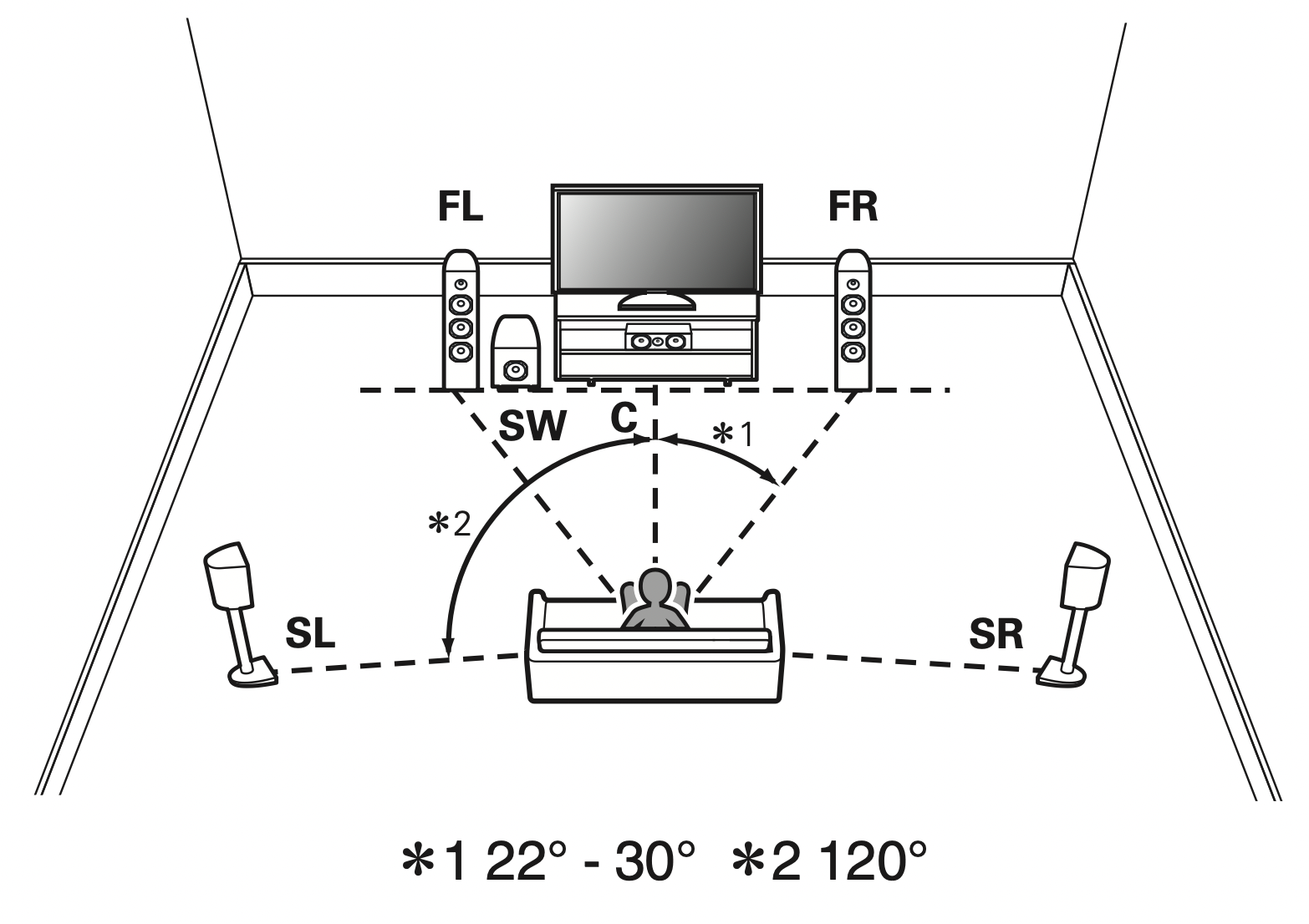
- Layout including height speakers and ceiling speakers
- Height speaker layout example
Combination of 5.1-channel layout and front height speakers.

- Ceiling speaker layout example
Combination of 5.1-channel layout and top middle speakers.
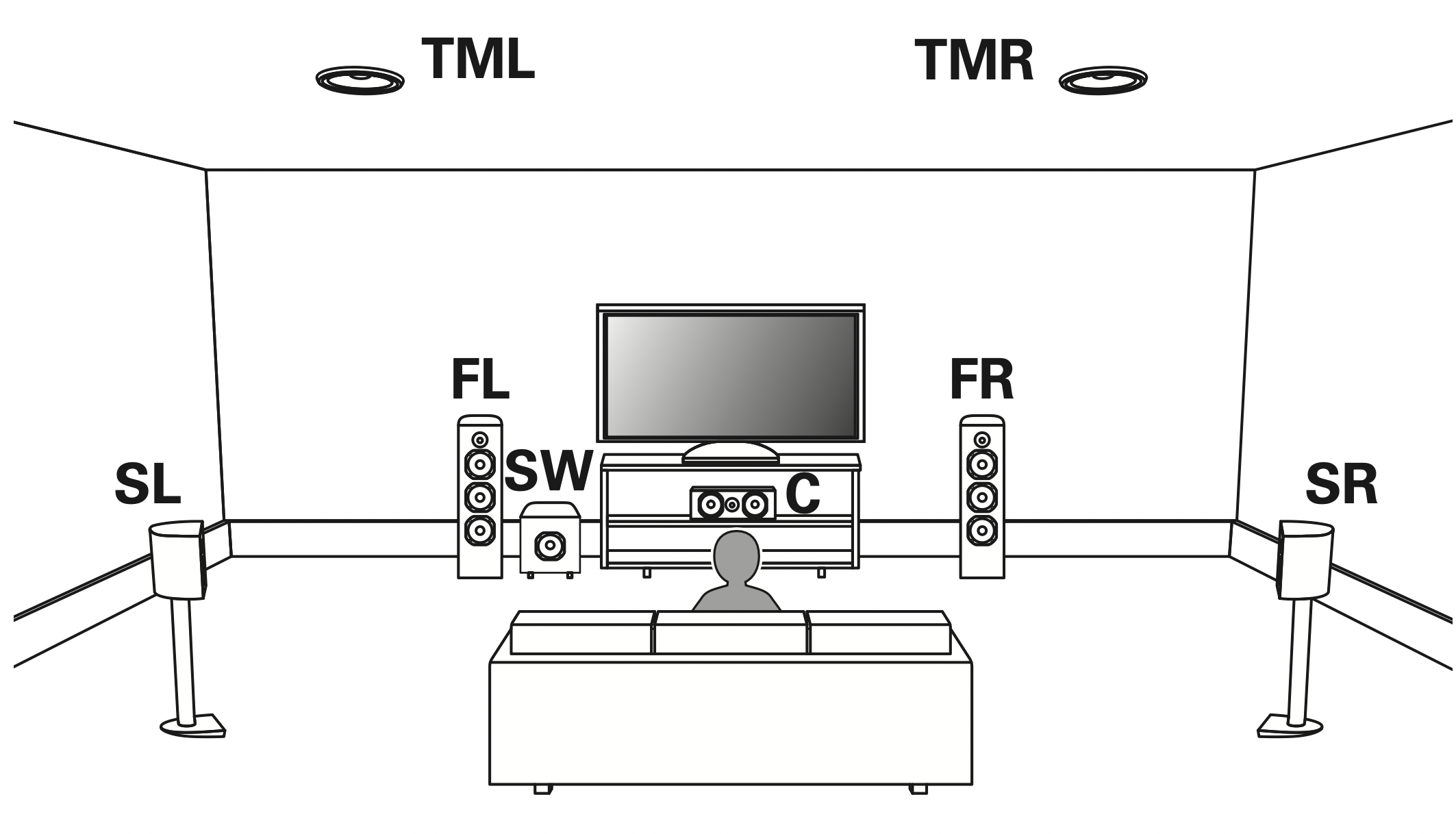
- Dolby Atmos Enabled speaker layout example
Dolby Atmos Enabled speaker layout example

- Height speaker layout example
Connecting speakers
Here we connect the speakers in the room to this unit.
Before connecting speakers
NOTE
- Disconnect this unit’s power plug from the power outlet before connecting the speakers. Also, turn off the subwoofer.
- Connect so that the speaker cable core wires do not protrude from the speaker terminal. The protection circuit may be activated if the core wires touch the rear panel or if the + and - sides touch each other. (“Protection circuit” (p. 268))
- Never touch the speaker terminals while the power cord is connected. Doing so could result in electric shock. When the “Setup Assistant” (page 8 in the separate “Quick Start Guide”) is running, follow the instructions in the “Setup Assistant” screen for making connections. (Power is not supplied to the speaker terminals while the “Setup Assistant” is running.)
- Use speakers with an impedance of 4 – 16 Ω/ohms.
NOTE
Carry out the following settings when using a speaker with an impedance of 4 – 6 Ω/ohms.
- Press and hold the main unit’s TUNER PRESET CH + and TUNE + at the same time for at least 3 seconds. “V.Format:< NTSC>” appears on the display.
- Press DIMMER on the main unit three times. “Sp.Imp.:<8ohms>” appears on the display.
- Press TUNER PRESET CH + or TUNER PRESET CH - on the main unit to select the impedance.

- Press the main unit’s STATUS to complete the setting.
- Connecting the speaker cables
Carefully check the left (L) and right (R) channels and + (red) and (black) polarities on the speakers being connected to this unit, and be sure to connect the channels and polarities correctly.
- Peel off about 3/8 inch (10 mm) of sheathing from the tip of the speaker cable, then either twist the core wire tightly or terminate it.
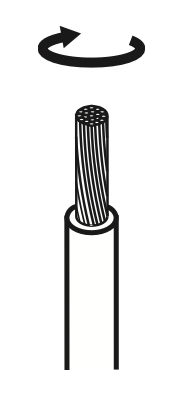
- Turn the speaker terminal counterclockwise to loosen it.

- Insert the speaker cable’s core wire to the hilt into the speaker terminal.

- Turn the speaker terminal clockwise to tighten it.
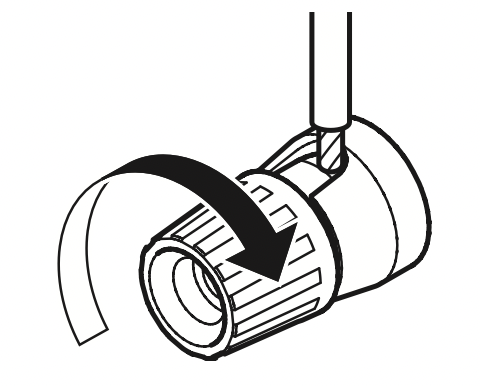
- Connecting the subwoofer
Use a subwoofer cable to connect the subwoofer. Two subwoofers can be connected to this unit.The same signal is output from the respective subwoofer terminals.
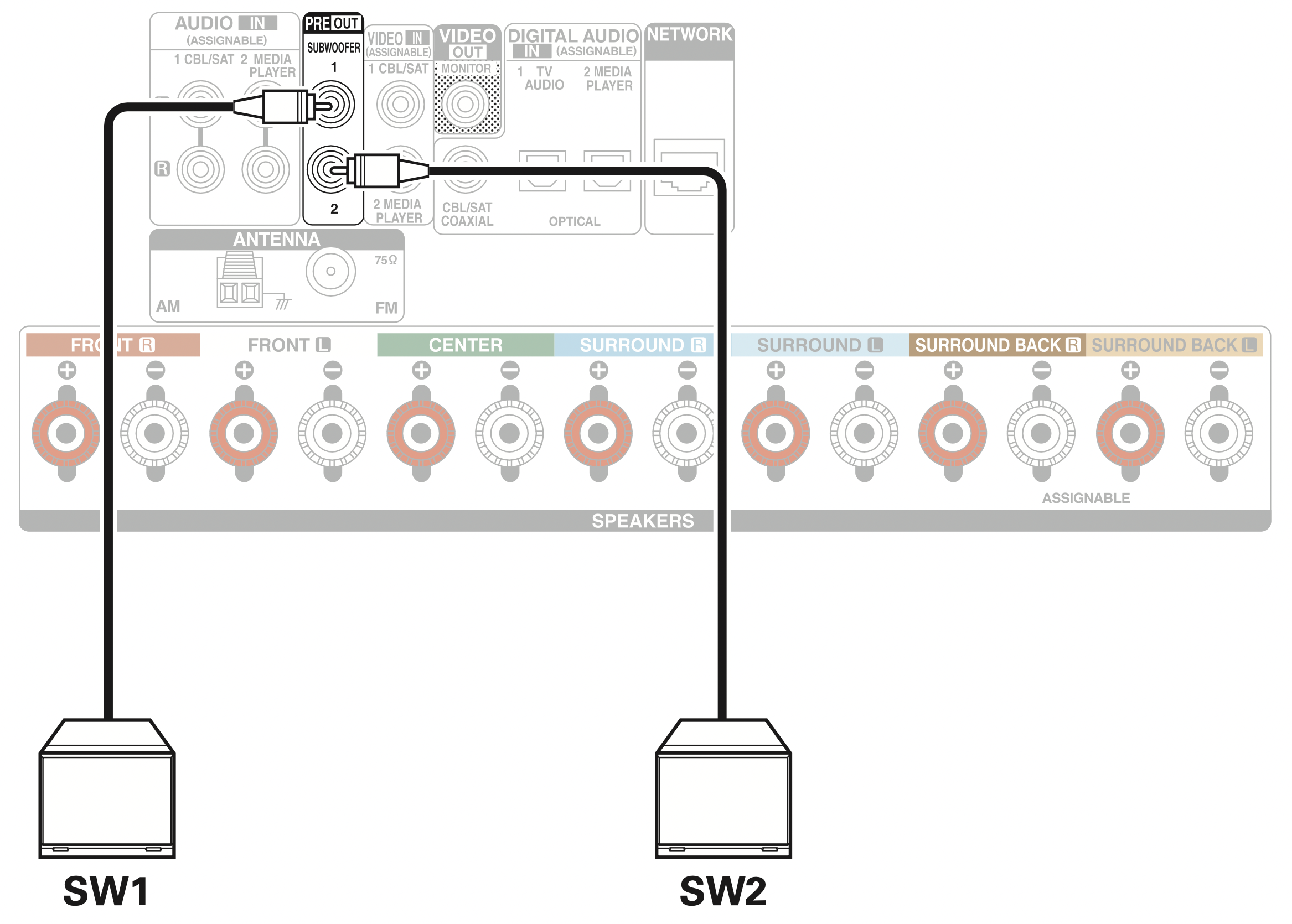
- About the cable labels (supplied) for channel identification
The channel display section for speaker terminals on the rear panel is color-coded for each channel to be identifiable.
Attach the cable label corresponding to each speaker to each speaker cable.
This makes it easy to connect the correct cable to the speaker terminals on the rear panel.

Attach the cable label for each channel to its speaker cable as shown in the diagram.
Refer to the table and attach the label to each speaker cable.
Then, make connection so that the color of the speaker terminal matches that of the cable label.

Speaker configuration and “Amp Assign” settings
This unit has a built-in 7-channel power amplifier. In addition to the basic 5.1-channel system, a variety of speaker systems can be configured by changing the “Amp Assign” settings to suit the application, such as 7.1-channel systems and 2-channel systems for multi-zone playback. (p. 183)
Perform “Amp Assign” settings to suit the number of rooms and speaker configuration to be installed. (p. 183)

NOTE: The sound mode that can be selected varies according to the speaker configuration. See “Sound modes and channel output” (v p. 251) for the sound modes that are supported.
Connecting 7.1-channel speakers
System for 7.1-channel surround playback.
- Example connections when using surround back speakers
This 7.1-channel surround system is the same as a basic 5.1-channel system but with surround back speakers.
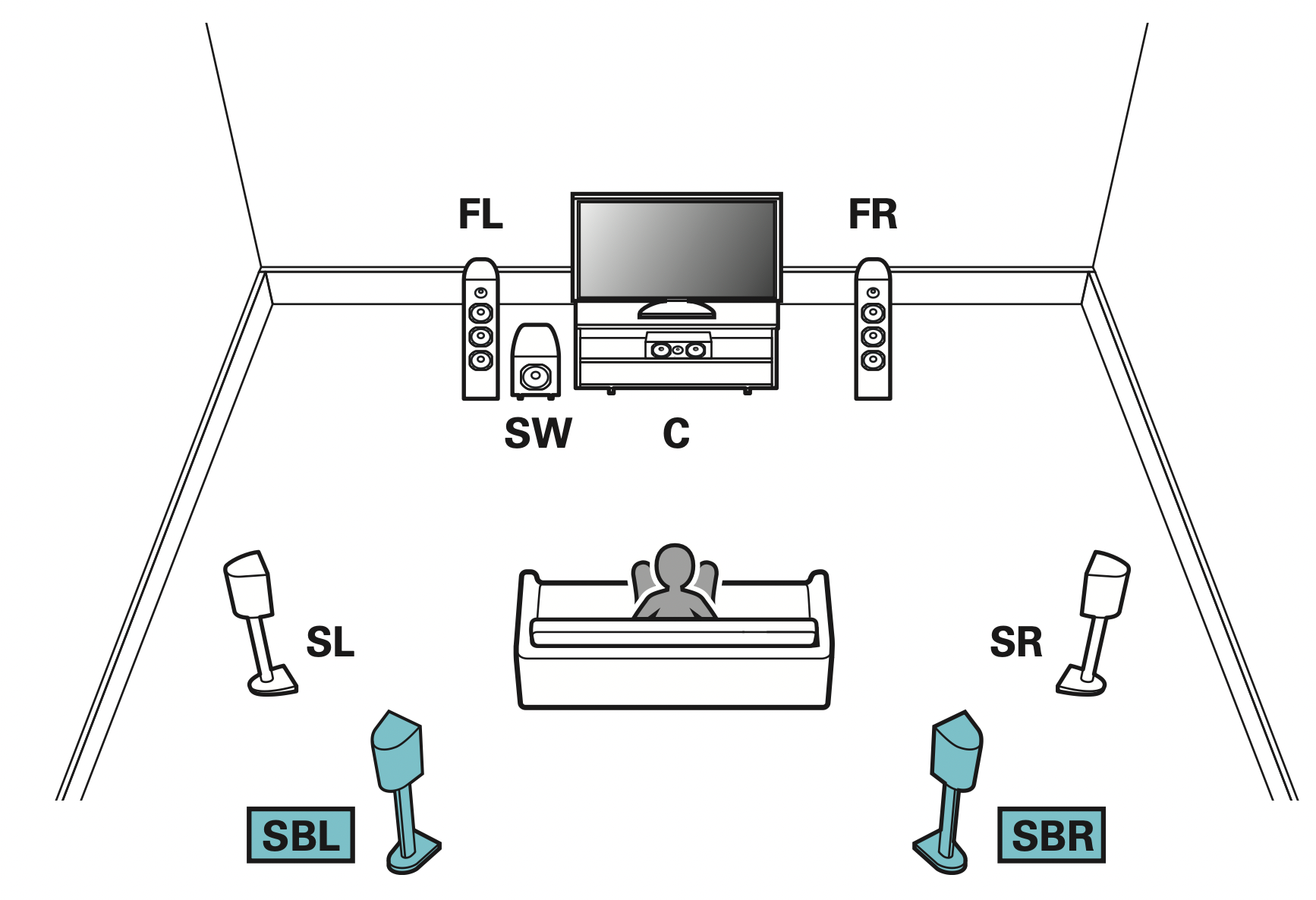
NOTE: Set “Assign Mode” to “Surround Back” in the menu. (p. 183)
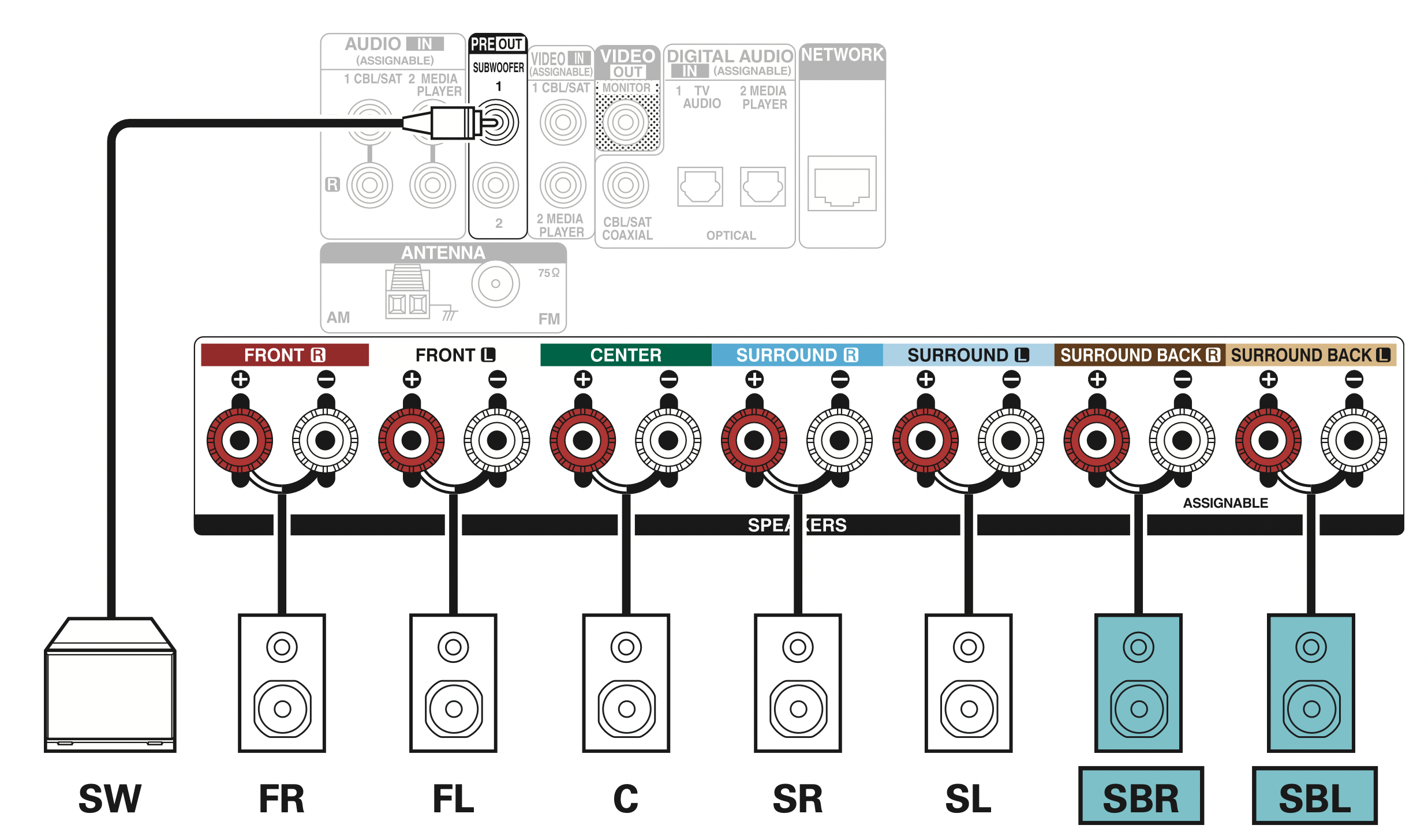
NOTE: When using a single surround back speaker, connect it to the SURROUND BACK L terminal.
- Example connections when using front height speakers
This 7.1-channel surround system is the same as a basic 5.1-channel system but with front height speakers.

NOTE: Set “Assign Mode” to “Front Height” in the menu. (p. 183)
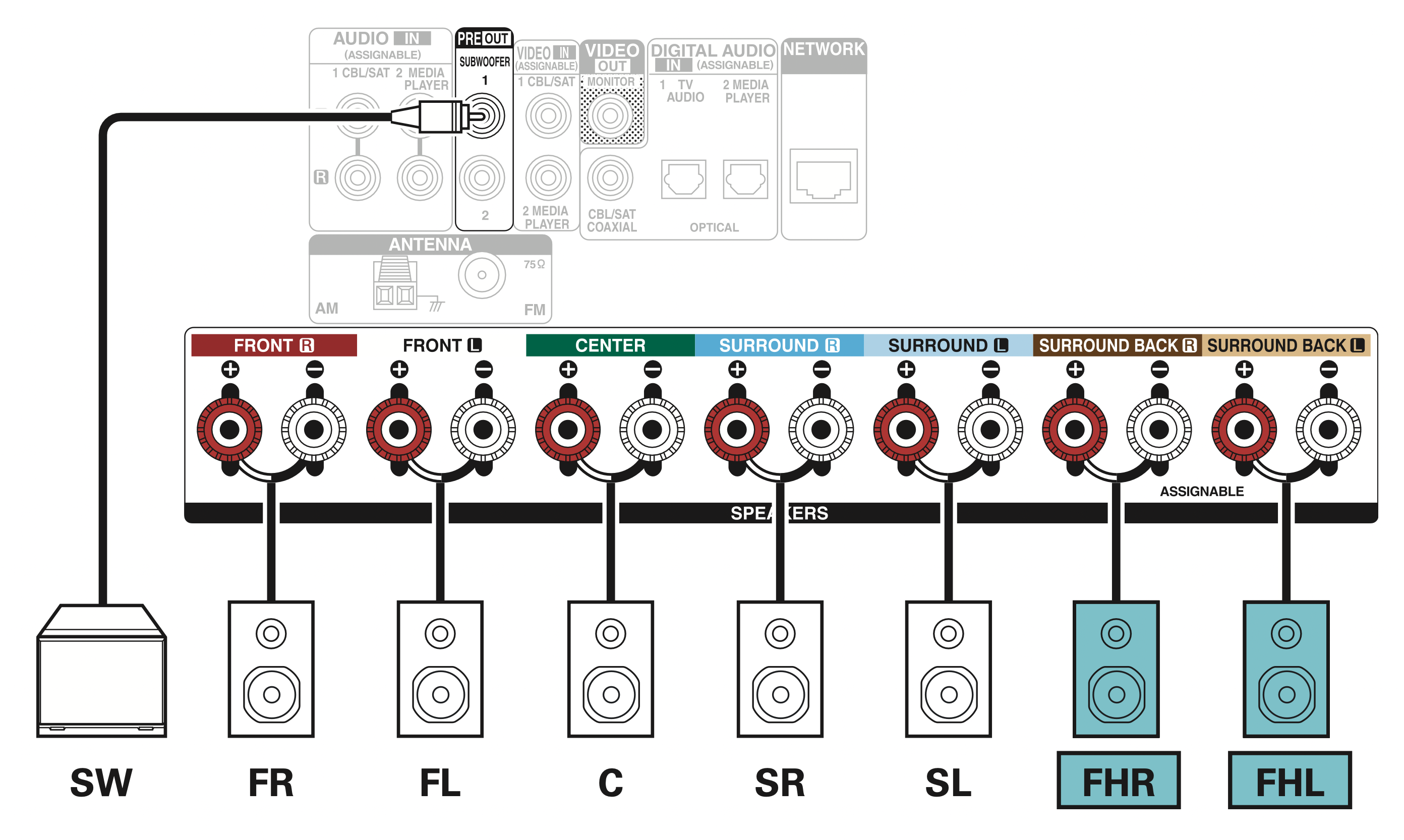
- Example connections when using top front speakers
This 7.1-channel surround system is the same as a basic 5.1-channel system but with top front speakers.

NOTE: Set “Assign Mode” to “Top Front” in the menu. (p. 183)
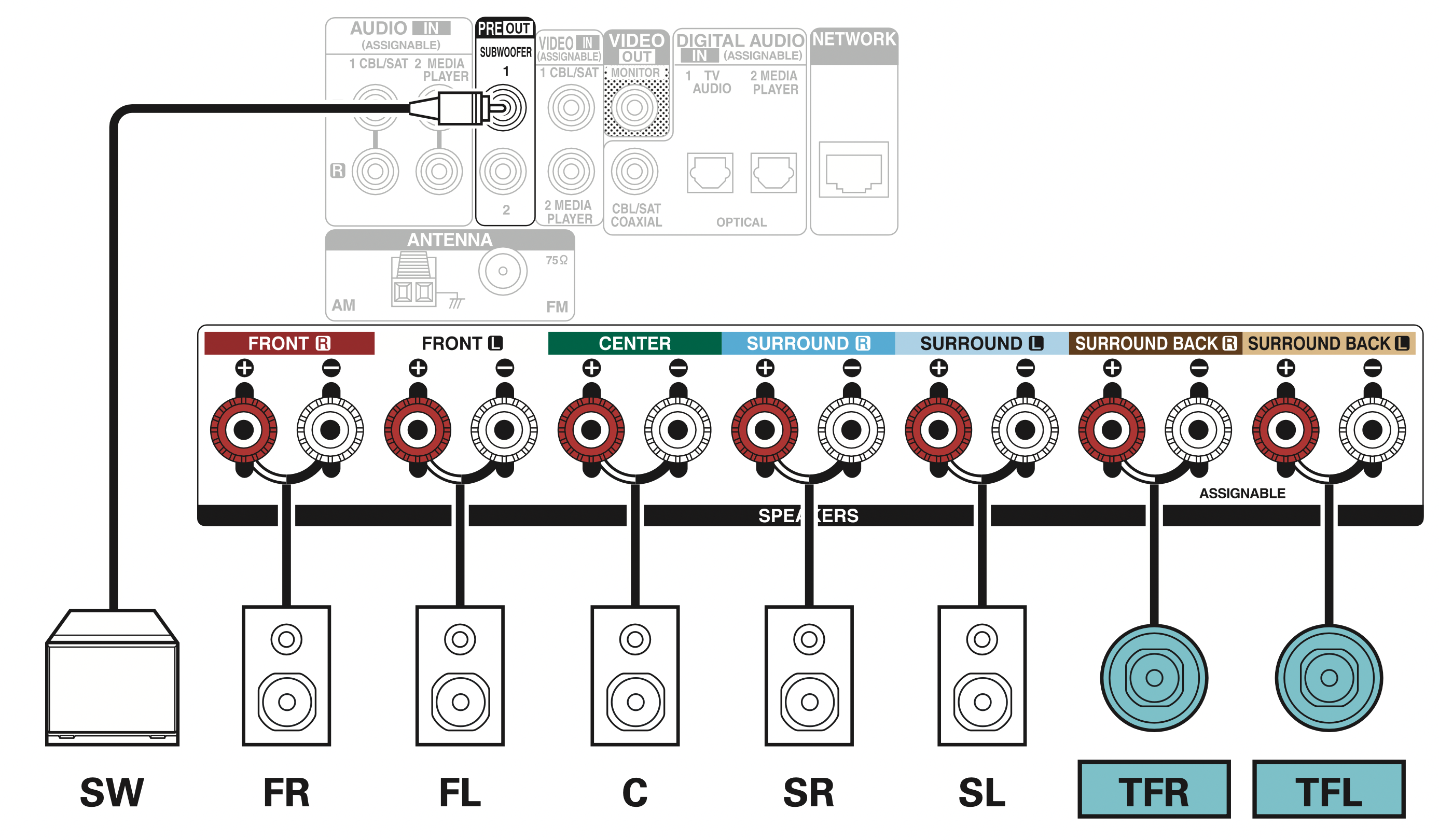
- Example connections when using top middle speakers
This 7.1-channel surround system is the same as a basic 5.1-channel system but with top middle speakers.
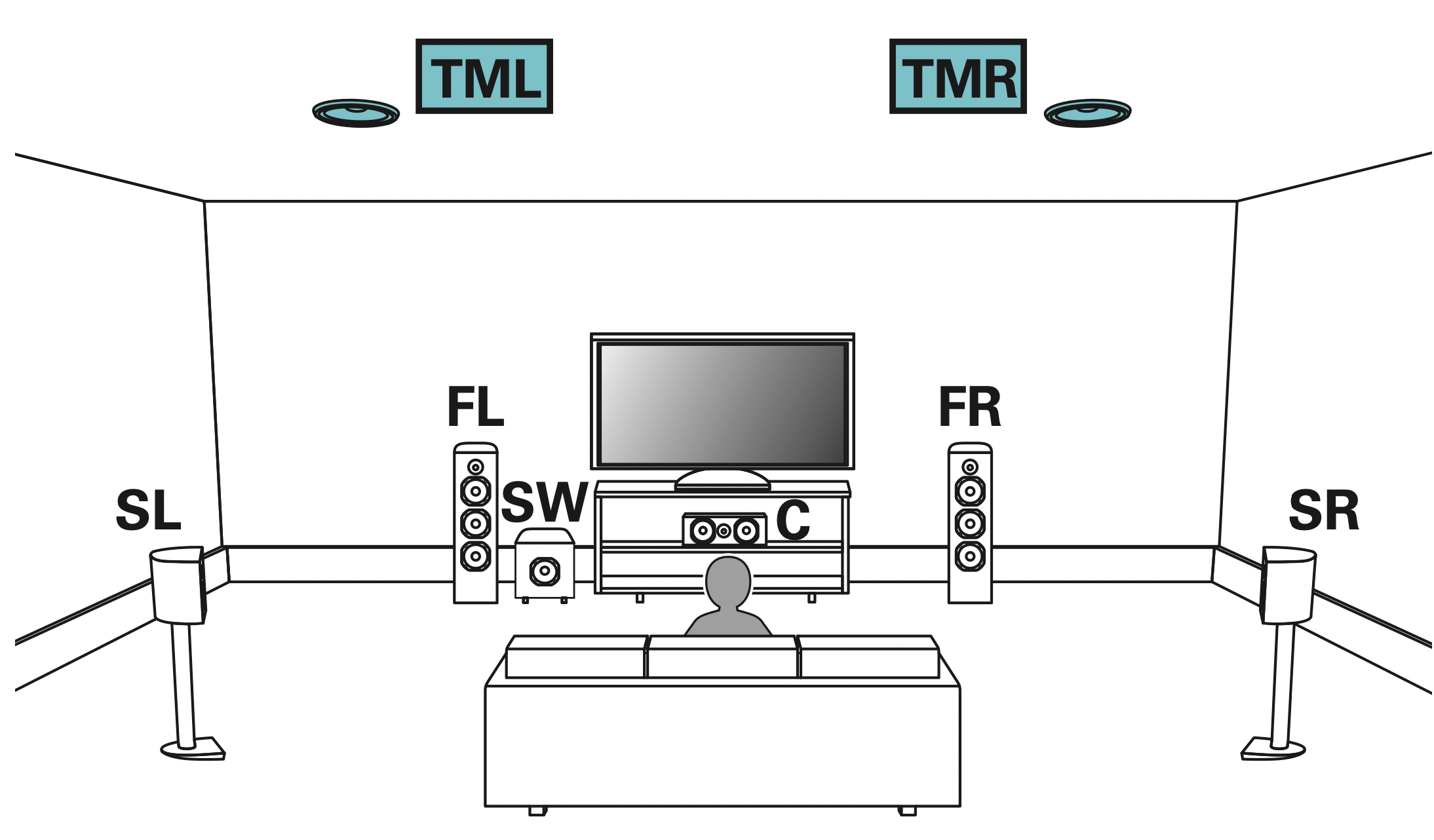
NOTE: Set “Assign Mode” to “Top Middle” in the menu. (p. 183)

- Example connections when using front Dolby Atmos Enabled speakers
This 7.1-channel surround system is the same as a basic 5.1-channel system but with front Dolby Atmos Enabled speakers.
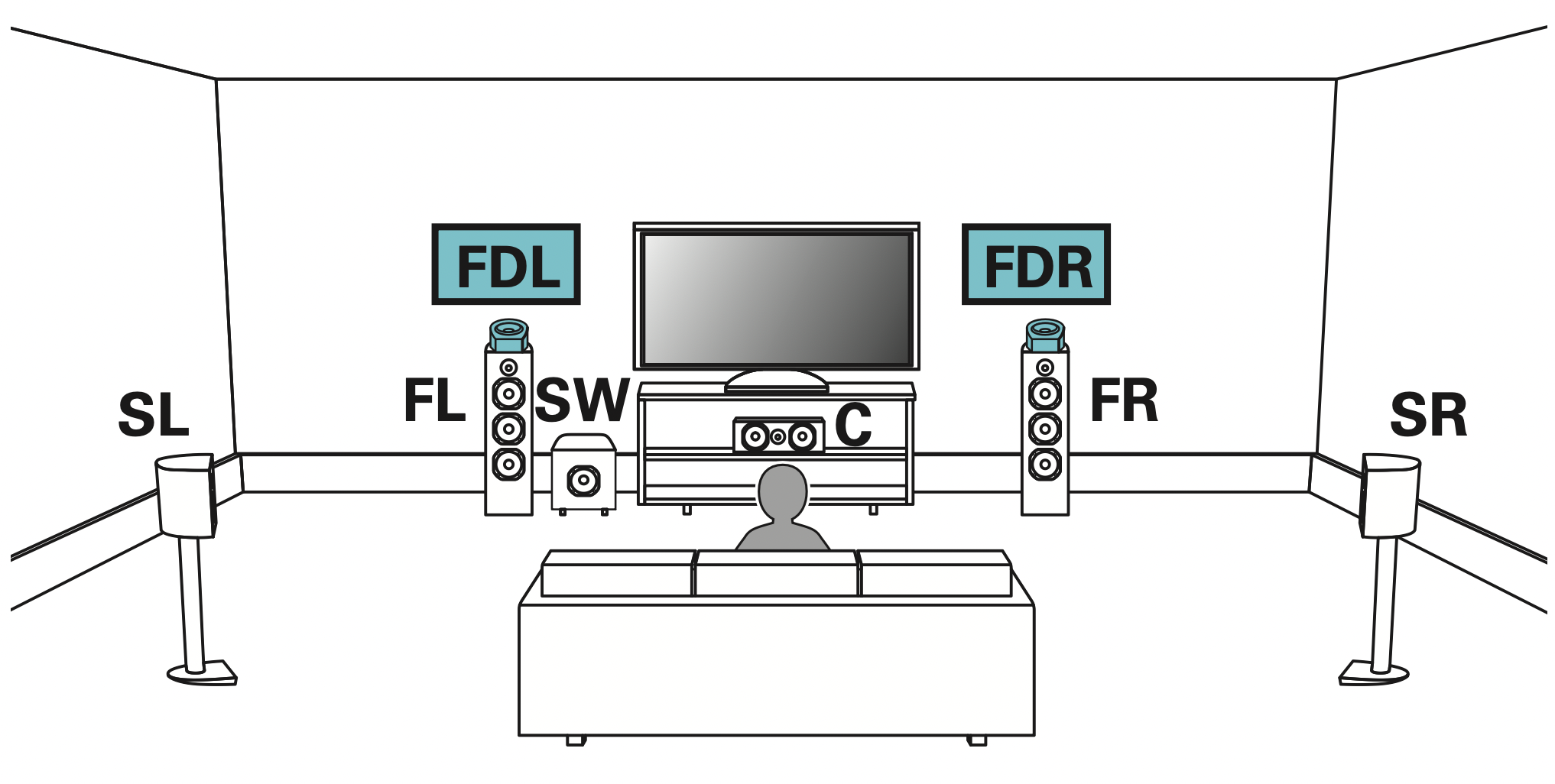
NOTE: Set “Assign Mode” to “Front Dolby” in the menu. (p. 183)
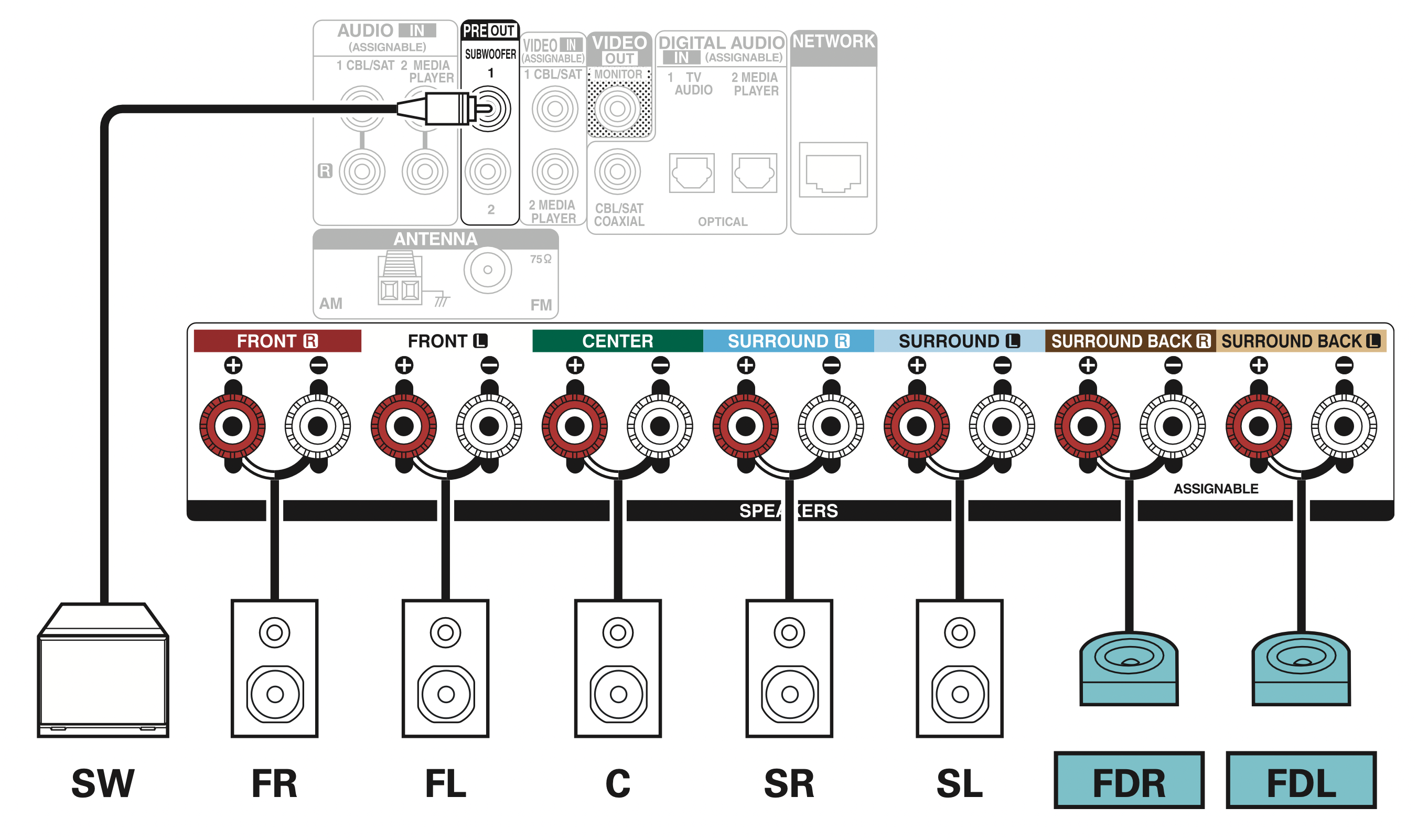
- Example connections when using surround Dolby Atmos Enabled speakers
This 7.1-channel surround system is the same as a basic 5.1-channel system but with surround Dolby Atmos Enabled speakers.

NOTE: Set “Assign Mode” to “Surround Dolby” in the menu. (p. 183)
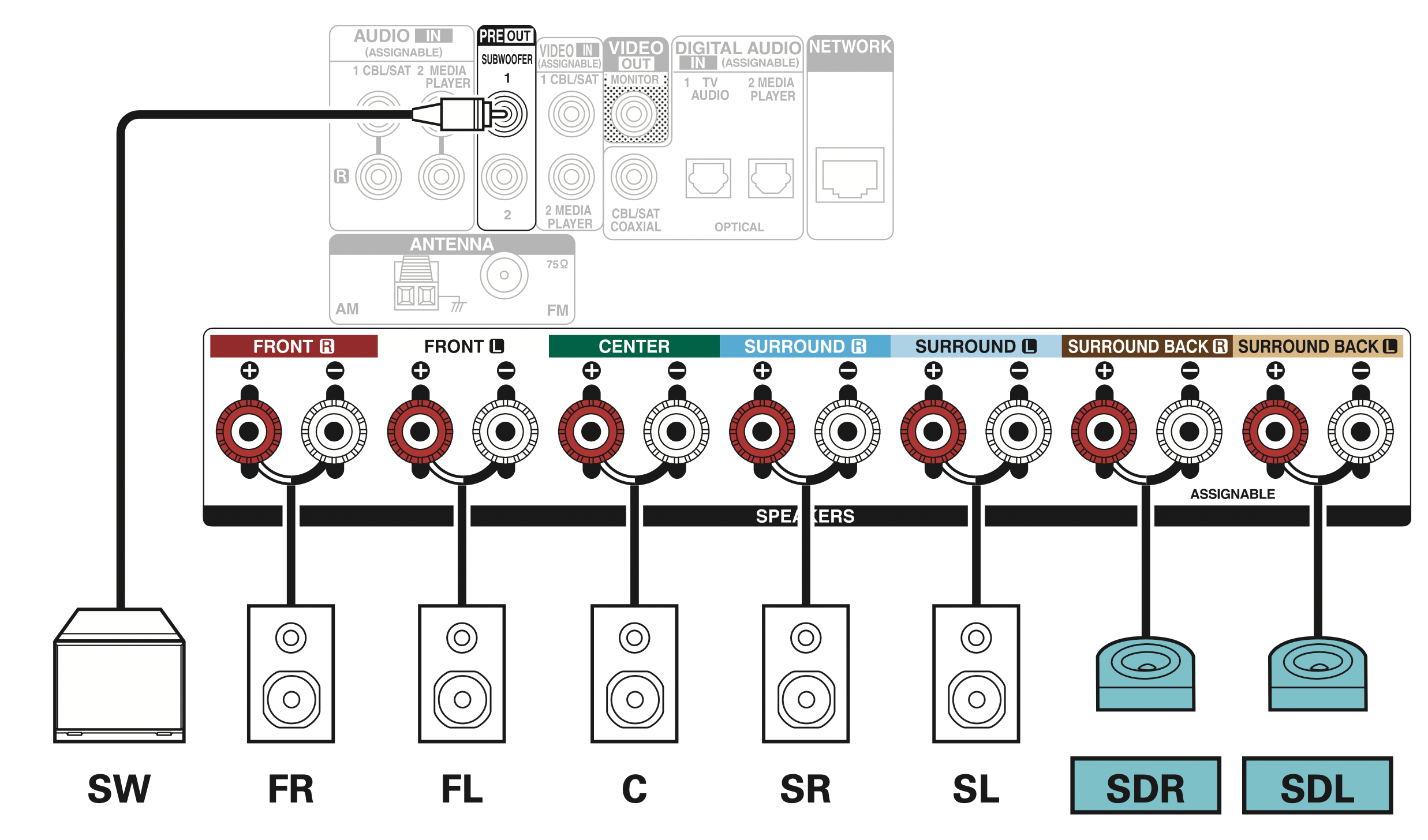
Connecting multi-zone speakers
- 5.1-channel (MAIN ZONE) + 2-channel (ZONE2) speaker connection
This connection method constructs a 5.1-channel speaker system in the MAIN ZONE and a 2-channel system in ZONE2.


NOTE: Set “Assign Mode” to “ZONE2” in the menu. (p. 183)
Basic operation
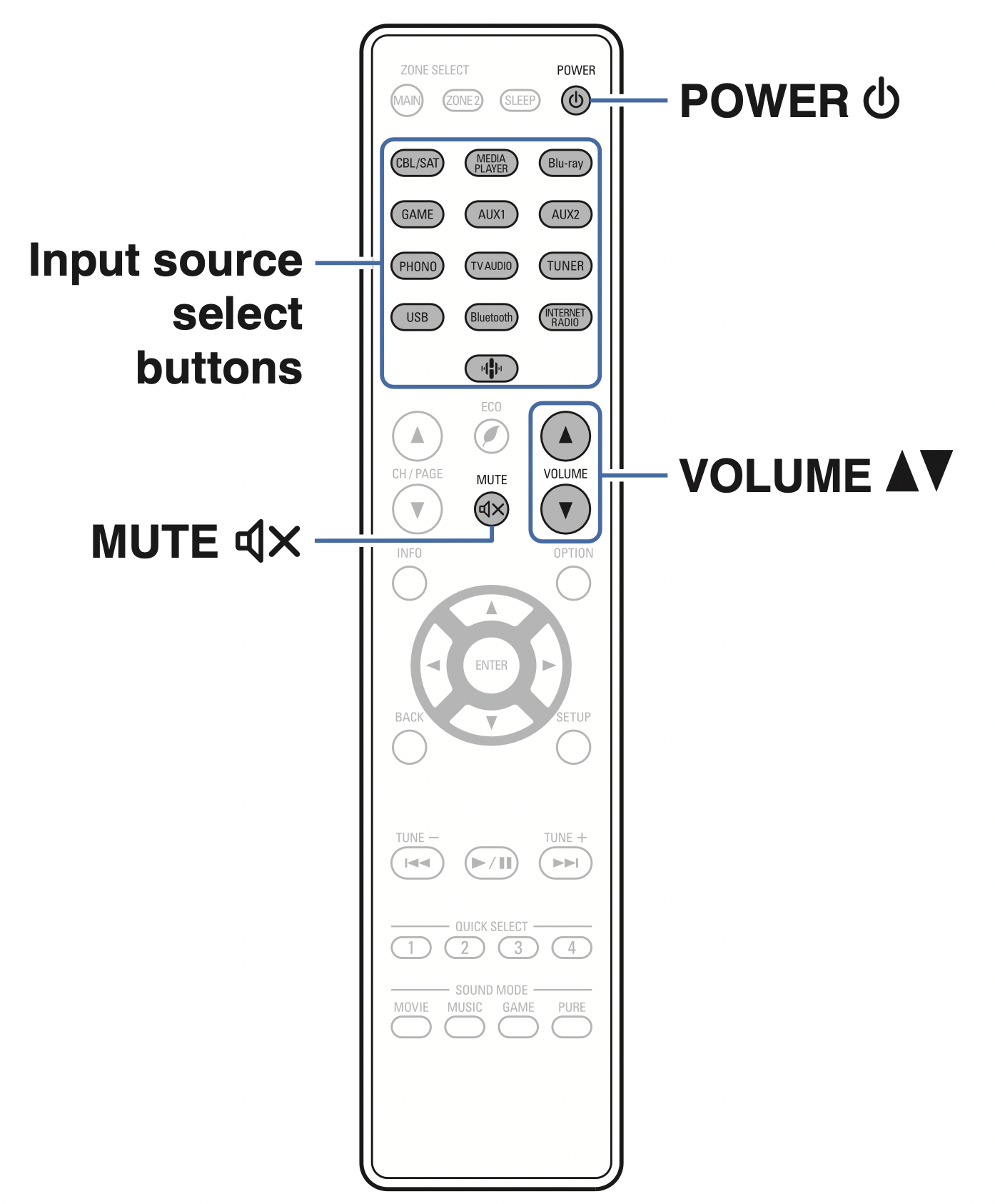
Turning the power on
- Press POWER
 to turn on power to the unit.
to turn on power to the unit.
NOTE:
- You can press the input source select button when the unit is in standby mode to turn on the power.
- You can also switch the power to standby by pressing
 on the main unit.
on the main unit.
Selecting the input source
- Press the input source select button to be played back.
The desired input source can be selected directly.
NOTE: You can also select the input source by turning SOURCE SELECT on the main unit.
Adjusting the volume
- Use VOLUME
 to adjust the volume.
to adjust the volume.
NOTE:
- The variable range differs according to the input signal and channel level setting.
- You can also adjust the master volume by turning MASTER VOLUME on the main unit.
Turning off the sound temporarily (Muting)
- Press MUTE

MUTE indicator on the display flashes.
 appears on the TV screen.
appears on the TV screen.
NOTE:
- The sound is reduced to the level set at “Mute Level” in the menu. (p. 153)
- To cancel mute, either adjust the sound volume or press MUTE
 again.
again. - If
 is displayed on the TV screen for more than 5 minutes when the “Screensaver” is set to “On”, the
is displayed on the TV screen for more than 5 minutes when the “Screensaver” is set to “On”, the  symbol moves randomly over the TV screen. (p. 165)
symbol moves randomly over the TV screen. (p. 165)
Playback a Blu-ray Disc player/DVD player
The following describes the procedure for playing Blu-ray Disc player/DVD player.
- Prepare for playback.
1. Turn on the power of the TV, subwoofer and player.
2. Change the TV input to the input of this unit. - Press POWER
 to turn on power to the unit.
to turn on power to the unit. - Press Blu-ray to switch an input source for a player used for playback.
- Play the Blu-ray Disc player or DVD player.
- Surround playback (p. 114)
Troubleshooting
If a problem should arise, first check the following:
- Are the connections correct?
- Is the set being operated as described in the owner’s manual?
- Are the other devices operating properly?
NOTE: If steps 1 to 3 above do not improve the problem, restarting the device may improve the problem.
Continue pressing the X button on the unit until “Restart” appears in the display, or remove and re-insert the power cord of the unit.
If this unit does not operate properly, check the corresponding symptoms in this section.
If the symptoms do not match any of those described here, consult your dealer as it could be due to a fault in this unit. In this case, disconnect the power immediately and contact the store where you purchased this unit.
Power does not turn on / Power is turned off
Power does not turn on.
- Check whether the power plug is correctly inserted into the power outlet. (p. 63)
Power automatically turns off.
- The sleep timer is set. Turn on the power again. (p. 128)
- “Auto Standby” is set. “Auto Standby” is triggered when there is no operation for a set amount of time. To disable “Auto Standby”, set “Auto Standby” on the menu to “Off”. (p. 204)
Power turns off and the power indicator flashes in red approx. every 2 seconds.
- The protection circuit has been activated due to a rise in temperature within this unit. Turn the power off, wait about an hour until this unit cools down sufficiently, and then turn the power on again. (p. 268)
- Please re-install this unit in a place having good ventilation.
Power turns off and the power indicator flashes in red approx. every 0.5 seconds.
- Check the speaker connections. The protection circuit may have been activated because speaker cable core wires came in contact with each other or a core wire was disconnected from the connector and came in contact with the rear panel of this unit. After unplugging the power cord, take corrective action such as firmly re-twisting the core wire or taking care of the connector, and then reconnect the wire. (p. 35)
- Turn down the volume and turn on the power again. (p. 65)
- This unit’s amplifier circuit has failed. Unplug the power cord and contact our customer service center.
Power does not turn off even when the power button is pressed, and the display shows “ZONE2 On”.
- The power supply of ZONE2 is turned to ON. To turn off the power supply of this unit (standby), press the ZONE2 ON/OFF on the main unit, or press the POWER
 button after pressing the ZONE2 button on the remote control unit to turn off the power supply of ZONE2.
button after pressing the ZONE2 button on the remote control unit to turn off the power supply of ZONE2.
Operations cannot be performed through the remote control unit
Operations cannot be performed through the remote control unit.
- Batteries are worn out. Replace with new batteries. (p. 9)
- Operate the remote control unit within a distance of about 23 ft/7 m from this unit and at an angle of within 30°. (p. 9)
- Remove any obstacle between this unit and the remote control unit.
- Insert the batteries in the proper direction, checking the + and - marks. (p. 9)
- The set’s remote control sensor is exposed to strong light (direct sunlight, inverter type fluorescent bulb light, etc.). Move the set to a place in which the remote control sensor will not be exposed to strong light.
- The operation target zone does not correspond to the zone setting specified on the remote control unit. Press the MAIN or ZONE2 button to select the operating zone of the remote control. (p. 146)
- When using a 3D video device, the remote control unit of this unit may not function due to effects of infrared communications between units (such as TV and glasses for 3D viewing). In this case, adjust the direction of units with the 3D communications function and their distance to ensure they do not affect operations from the remote control unit of this unit.
Display on this unit shows nothing
Display is off.
- Set “Dimmer” on the menu to something other than “Off”. (p. 207)
No sound comes out
No sound comes out of speakers.
- Check the connections for all devices. (p. 35)
- Insert connection cables all the way in.
- Check that input connectors and output connectors are not reversely connected.
- Check cables for damage.
- Check that speaker cables are properly connected. Check that cable core wires come in contact with the metal part on speaker terminals. (p. 35)
- Securely tighten the speaker terminals. Check speaker terminals for looseness. (p. 35)
- Check that a proper input source is selected. (p. 65)
- Adjust the volume. (p. 66)
- Cancel the mute mode. (p. 66)
- Check the digital audio input connector setting. (p. 168)
- Check the digital audio output setting on the connected device. On some devices, the digital audio output is set to off by default.
- When a headphone is plugged into the PHONES jack on the main unit, sound is not output from the speaker terminal and SUBWOOFER connector.
- Audio is output to your Bluetooth headphones, but not to speakers or pre-outs when “Output Mode” set to “Bluetooth Only”. Change “Output Mode” to “Bluetooth + Speakers” to output audio from your Bluetooth headphones as well as your speakers or pre-outs. (p. 205)
No sound comes out when using the DVI-D connection.
- When this unit is connected to a device equipped with a DVI-D connector, no sound is output. Make a separate audio connection.
Desired sound does not come out
The volume does not increase.
- The maximum volume is set too low. Set the maximum volume using “Limit” on the menu. (p. 153)
- Appropriate volume correction processing is performed according to the input audio format and settings, so the volume may not reach the upper limit.
The volume of Bluetooth headphones does not decrease.
- Bluetooth headphones volume cannot be adjusted from this unit. Use a Bluetooth headphones with volume adjustment.
No sound comes out with the HDMI connection.
- Check the connection of the HDMI connectors. (p. 49)
- When outputting HDMI audio from the speakers, set “HDMI Audio Out” on the menu to “AVR”. To output from the TV, set “TV”. (p. 159)
- When using the HDMI Control function, check that the audio output is set to the AV amplifier on the TV. (p. 127)
When an eARC function-compatible television is connected, television audio is not output from the speaker connected to this unit
- eARC function settings may be required depending on the eARC function-compatible television you are using. Make sure eARC is set to on if this setting exists on your television. For more information, check your television’s owner’s manual.
- Make sure the input source of this unit is “TV Audio”.
- The eARC function does not operate when the HDMI input connector is set to the “TV Audio” input source. To enable eARC function operation, remove the HDMI input connector setting, then restart this unit and the television. (p. 169)
No sound comes out of a specific speaker.
- Check that speaker cables are properly connected.
- Check that a selection other than “None” is set for the “Speaker Config.” setting in menu. (p. 184)
- Check the “Assign Mode” setting in the menu. (p. 183)
- When the sound mode is “Stereo” and “Virtual”, audio is only output from the front speakers and subwoofer.
- Audio is not output from the surround back speaker if “Sp.Virtualizer” is set to “On” when “Speaker Config.” - “Surround Back” is set to “1 spkr” in the menu. (p. 150)
No sound is produced from subwoofer.
- Check the subwoofer connections.
- Turn on the subwoofer’s power.
- Set “Speaker Config.” – “Subwoofer” on the menu to “Yes”. (p. 184)
- When “Speaker Config.” - “Front” in the menu is set to “Large”, depending on the input signal and the sound mode, no sound may be output from the subwoofer. (p. 184)
- When no subwoofer audio signal (LFE) is included in the input signals, no sound may be output from the subwoofer. (p. 191)
- You can make the subwoofer always output sound by setting the “Subwoofer Mode” to “LFE+Main”. (p. 191)
DTS sound is not output.
- Check that the digital audio output setting on the connected device is set to “DTS”.
Dolby Atmos, Dolby TrueHD, DTS-HD, Dolby Digital Plus audio is not output.
- Make HDMI connections. (p. 53)
- Check the digital audio output setting on the connected device. On some devices, “PCM” is set by default.
DTS Neural:X mode cannot be selected.
- DTS Neural:X cannot be selected when using the headphones.
Dolby Surround mode cannot be selected.
- Dolby Surround cannot be selected when using the headphones.
Sound modes other than “Stereo” or “Direct” cannot be selected.
- Only “Stereo” or “Direct” can be selected for the sound mode if Headphone:X signals are input.
Audyssey MultEQ® , Audyssey Dynamic EQ ® and Audyssey Dynamic Volume ® cannot be selected.
- These cannot be selected when you have not performed Audyssey® Setup. (p. 172)
- Switch to a sound mode other than “Direct”. (p. 116)
- These cannot be selected when sound mode is “DTS Virtual:X” or sound mode that have “+Virtual:X” in the sound mode name.
- These cannot be selected when using the headphones.
“Restorer” cannot be selected.
- Check that an analog signal or PCM signal (Sample Rate = 44.1/48 kHz) is input. For playback of multichannel signals such as Dolby Digital or DTS surround, “Restorer” cannot be used. (p. 152)
- Switch to a sound mode other than “Direct”. (p. 116)
No sound is output when using ZONE2.
- Digital signal audio input from the HDMI connector or digital audio connectors (OPTICAL/COAXIAL) cannot be played back. Use analog connections.
- When listening to audio from a Bluetooth device in ZONE2, remove any obstructions between the Bluetooth device and this unit and use it within a range of about 98.4 ft/30 m.
Sound mode settings are not available when using Bluetooth headphones. Audio menu settings are also not available.
- This unit cannot change sound mode or audio menu settings for audio output to Bluetooth headphones.
Sound is interrupted or noise occurs
During playback from the Internet radio or USB memory device, sound is occasionally interrupted.
- When the transfer speed of the USB memory device is slow, sound may occasionally be interrupted.
- The network communication speed is slow or the radio station is busy.
When making a call on iPhone, noise occurs in audio output on this unit.
- When making a call, keep a distance of 0.7 ft/20 cm or longer between iPhone and this unit.
Noise often occurs in FM/AM broadcasting.
- Change the antenna orientation or position. (p. 59)
- Separate the AM loop antenna from the unit.
- Use an outdoor antenna. (p. 59)
- Separate the antenna from other connection cables. (p. 59)
The sounds appear to be distorted.
- Lower the volume. (p. 66)
- Set “Off” to the “ECO Mode”. When “On” or “Auto” is in the “ECO Mode”, the audio may by distorted when the playback volume is high. (p. 201)
Sound cuts out when using Wi-Fi connection.
- The frequency band used by the wireless LAN is also used by microwave ovens, cordless telephones, wireless game controllers and other wireless LAN devices. Using such devices at the same time as this unit may cause sound to cut out due to electronic interference. Sound cut out can be improved using the following methods. (p. 61)
- Install devices that cause interference away from this unit.
- Turn off the power supply to devices that cause interference.
- Change the settings of the router channel to which this unit is connected to. (See the instruction manual of the wireless router for details on how to change the channel.)
- Switch to a wired LAN connection.
- Particularly when you play back large music files, depending on your wireless LAN environment, the playback sound may be interrupted. In this case, make the wired LAN connection. (p. 194)
No video is shown on the TV
No picture appears.
- Check the connections for all devices. (p. 49)
- Insert connection cables all the way in.
- Check that input connectors and output connectors are not reversely connected.
- Check cables for damage.
- Match the input settings to the input connector of the TV connected to this unit. (p. 168)
- Check that the proper input source is selected. (p. 65)
- Check the video input connector setting. (p. 168)
- Check that the resolution of the player corresponds to that of the TV. (p. 211)
- Check whether the TV is compatible with copyright protection (HDCP). If connected to a device not compatible with HDCP, video will not be output correctly. (p. 244)
- To enjoy content that is copyright protected by HDCP 2.2 or HDCP 2.3, use a playback device and TV compatible with HDCP 2.2 or HDCP 2.3.
- To play back a 4K video, use a “High Speed HDMI Cable” or an “High Speed HDMI Cable with Ethernet”. In order to achieve a higher fidelity for 4K videos, it is recommended to use a “Premium High Speed HDMI Cables” or an “Premium High Speed HDMI Cables with Ethernet” that has an HDMI Premium Certified Cable label on the product package.
- Use a certified “Ultra High Speed HDMI cable” to enjoy 8K or 4K 120Hz video. If you use a different HDMI cable, the video may not be displayed or other problems may occur.
No video is shown on the TV with the DVI-D connection.
- With the DVI-D connection, on some device combinations, devices may not function properly due to the copy guard copyright protection (HDCP). (p. 244)
While the menu is being displayed, no video is shown on the TV.
- The video being played will not appear in the background of the menu when the menu is operated.
The menu screen is not displayed on the TV
The menu screen or status information screen is not displayed on the TV.
- The menu screen is only displayed on this unit and a TV connected with an HDMI cable. If this unit is connected to a TV using a different video output connector, operate while watching the display on this unit.
- The status information will not appear on the TV when the following video signals are being played.
- Some images of 3D video content
- Computer resolution images (example: VGA)
- Video with an aspect ratio other than 16:9 or 4:3
- Some kind of HDR signals
- Some kind of game contents
- Compressed video
- When a 2D video is converted to a 3D video on the TV, the menu screen or status information screen is not displayed properly. (p. 212)
- Set the “TV Format” setting in the menu to a selection that is appropriate for the TV. (p. 167)
The color of the menu screen and operations content displayed on the television is different from normal
The color of the menu screen and operations content displayed on the television is different.
- Performing operations on this unit during playback of a Dolby Vision signal may cause variance in the color display of the menu screen and operations content. This is a characteristic of the Dolby Vision signal and is not a malfunction.
AirPlay cannot be played back
The AirPlay icon is not displayed on iTunes / iPhone / iPod touch / iPad.
- This unit and PC / iPhone / iPod touch / iPad are not connected to the same network (LAN). Connect it to the same LAN as this unit. (p. 61)
- The firmware on iTunes / iPhone / iPod touch / iPad is not compatible with AirPlay. Update the firmware to the latest version.
Audio is not output.
- The volume on iTunes / iPhone / iPod touch / iPad is set to the minimum level. The volume on iTunes / iPhone / iPod touch / iPad is linked with the volume on this unit. Set a proper volume level.
- The AirPlay playback is not performed, or this unit is not selected. Click the AirPlay icon on the iTunes / iPhone / iPod touch / iPad screen and select this unit. (p. 102)
Audio is interrupted during the AirPlay playback on iPhone / iPod touch / iPad.
- Quit the application running in the background of the iPhone/iPod touch/iPad, and then play using AirPlay.
- Some external factors may be affecting the wireless connection. Modify the network environment by taking measures such as shortening the distance from the wireless LAN access point.
iTunes cannot be played back through the remote control unit.
- Enable the “Allow iTunes audio control from remote speakers” setting on iTunes. Then, you can perform playback, pause, and skip operations through the remote control unit.
USB memory devices cannot be played back
USB memory device is not recognized.
- Disconnect and reconnect the USB memory device. (p. 58)
- Mass storage class compatible USB memory devices are supported.
- This unit does not support a connection through a USB hub. Connect the USB memory device directly to the USB port.
- The USB memory device must be formatted to “FAT32” or “NTFS”.
- Not all USB memory devices are guaranteed to work. Some USB memory devices are not recognized. When using a type of portable hard disc drive compatible with the USB connection that requires power from an AC adapter, use the AC adapter that came with the drive.
Files on the USB memory device are not displayed.
- Files of a type not supported by this unit are not displayed. (p. 67)
- This unit is able to display files in a maximum of eight folder layers. A maximum of 5000 files (folders) can also be displayed for each layer. Modify the folder structure of the USB memory device.
- When multiple partitions exist on the USB memory device, only files on the first partition are displayed.
iOS and Android devices are not recognized.
- The USB port of this unit does not support playback from iOS and Android devices.
Files on a USB memory device cannot be played.
- Files are created in a format that is not supported by this unit. Check the formats supported by this unit. (p. 247)
- You are attempting to play a file that is copyright protected. Files that are copyright protected cannot be played on this unit.
- Playback may not be possible if the album art file size exceeds 2 MB.
Bluetooth cannot be played back
Bluetooth devices cannot be connected to this unit.
- The Bluetooth function in the Bluetooth device has not been enabled. See the Owner’s Manual of the Bluetooth device to enable the Bluetooth function.
- Bring the Bluetooth device near to this unit.
- The Bluetooth device cannot connect with this unit if it is not compatible with the A2DP profile.
- Turn the power of the Bluetooth device off and on again, and then try again.
Smartphones and other Bluetooth devices cannot be connected.
- Smartphones and other Bluetooth devices cannot be connected when “Transmitter” is set to “On”. Press Bluetooth on the remote control to switch the input source to Bluetooth, then connect the device. (p. 205)
Cannot connect Bluetooth headphones.
- Bring the Bluetooth headphones near to this unit.
- Turn the power of the Bluetooth headphones off and on again, and then try again.
- Go to “General” - “Bluetooth Transmitter”, and set “Transmitter” to “On” within the menu. (p. 205)
- Make sure this unit is not already connected to another pair of Bluetooth headphones. Check the currently connected Bluetooth headphones by pressing INFO on the remote control or STATUS button on the unit.
Disconnect the connected Bluetooth headphones before connecting the ones you want to use.
- Bluetooth headphones cannot be connected if Bluetooth is being used as an input source in any zone.
- Bluetooth headphones cannot be connected if this unit is grouped in the HEOS App. Remove this unit from the group to enable Bluetooth headphones connection.
- The Bluetooth headphones cannot connect with this unit if it is not compatible with the A2DP profile.
- Connection and operation are not guaranteed for all Bluetooth-enabled devices.
- This unit can only connect to one Bluetooth headphone at a time. However, up to 8 Bluetooth headphones can be registered. You can switch between registered devices from “Device List” in the “Bluetooth Transmitter” menu. (p. 205)
The sound is cut off.
- Bring the Bluetooth device near to this unit.
- Remove obstructions between the Bluetooth device and this unit.
- To prevent electromagnetic interference, locate this unit away from microwave ovens, wireless LAN devices and other Bluetooth devices.
- Reconnect the Bluetooth device.
The sound is cut off or noise occurs when using Bluetooth headphones.
- Move the Bluetooth headphones closer to this unit.
- Remove obstructions between the Bluetooth headphones and this unit.
- Reconnect the Bluetooth headphones.
- To prevent electromagnetic interference, locate this unit away from microwave ovens, wireless LAN devices and other Bluetooth devices.
- We recommend using wired LAN to connect this unit and other devices.
- Bluetooth transmits on the 2.4 GHz band which may interfere with Wi-Fi transmitted on this band. Connect this unit and other devices to Wi-Fi network on a 5 GHz band if available on your Wi-Fi router.
Audio is delayed on my Bluetooth headphones.
- This unit cannot adjust audio delay on Bluetooth headphones.
The Internet radio cannot be played back
A list of broadcasting stations is not displayed.
- The LAN cable is not properly connected, or the network is disconnected. Check the connection status. (p. 61)
- Perform the network diagnostic mode.
Internet Radio cannot be played.
- The selected radio station is broadcasting in a format that is not supported by this unit. Formats that can be played back in this unit are MP3, WMA and AAC. (p. 250)
- The firewall function is enabled on the router. Check the firewall setting.
- The IP address is not properly set. (p. 195)
- Check the power of the router is on.
- To obtain the IP address automatically, enable the DHCP server function on the router. Also, set the DHCP setting to “On” on this unit. (p. 195)
- To obtain the IP address manually, set the IP address on this unit. (p. 195)
- Some radio stations broadcast silently during some time period. In this case, no audio is output. Wait for a while and select the same radio station, or select another radio station. (p. 87)
- The selected radio station is not in service. Select a radio station in service.
Cannot connect to favorite radio stations.
- Radio station is not currently in service. Register radio stations in service.
Music files on PC or NAS cannot be played back
Files stored on a computer cannot be played.
- Files are stored in a non-compatible format. Record in a compatible format. (p. 249)
- Files that are copyright protected cannot be played on this unit.
- The USB port of this unit cannot be used for connection to a computer.
- Media sharing settings on the server or NAS do not allow this unit. Change the settings to allow this unit. For details, see the owner’s manual of the server or NAS.
Server is not found, or it is not possible to connect to the server.
- The computer’s or router’s firewall is activated. Check the computer’s or router’s firewall settings.
- Computer’s power is not turned on. Turn on the power.
- Server is not running. Launch the server.
- IP address of this unit is wrong. Check the IP address of this unit. (p. 193)
Music files on PC cannot be played back.
- Even if PC is connected to the USB port on this unit, music files on it cannot be played back. Connect PC to this unit through the network. (p. 61)
Files on PC or NAS are not displayed.
- Files of a type not supported by this unit are not displayed. (p. 249)
Music stored on a NAS cannot be played.
- If you use a NAS in conformity with the DLNA standard, enable the DLNA server function in the NAS setting.
- If you use a NAS that does not conform with the DLNA standard, play the music via a PC. Set Windows Media Player’s media sharing function and add NAS to the selected play folder.
- If connection is restricted, set audio equipment as the connection target.
Various online services cannot be played
Various online services cannot be played.
- The online service may have been discontinued.
The HDMI Control function does not work
The HDMI Control function does not work.
- Check that “HDMI Control” in the menu is set to “On”. (p. 161)
- You cannot operate devices that are not compatible with the HDMI Control function. In addition, depending on the connected device or the settings, the HDMI Control function may not work. In this case, operate the external device directly. (p. 127)
- Check that the HDMI Control function setting is enabled on all devices connected to this unit. (p. 127)
- When you make connection related changes such as connecting an additional HDMI device, the link operation settings may be initialized. Turn off this unit and devices connected via HDMI, and turn them on again. (p. 127)
Cannot connect to a wireless LAN network
Cannot connect to the network.
- The network name (SSID), password and encryption setting have not been set up correctly. Configure the network settings according to the setting details of this unit. (p. 195)
- Shorten the distance from the wireless LAN access point and remove any obstructions to improve access first before re-connecting again. Place the unit away from microwave ovens and other network access points.
- Configure the access point channel settings away from channels that are being used by other networks.
- This unit is not compatible with WEP (TSN).
Cannot connect to a WPS Router.
- Check that the WPS mode of the router is operating.
- Press the WPS button on the router and then press the “Connect” button displayed on the TV within 2 minutes.
- A router/settings that are compatible with WPS 2.0 standards are required. Set the encryption time to “None”, “WPA-PSK (AES)” or WPA2-PSK (AES). (p. 195)
- If the router encryption method is WEP/WPA-TKIP/WPA2-TKIP/WPA3-SAE (AES), you cannot connect by using the WPS button on the router. In this case, use the “Scan Networks” or “Manual” method to connect.
Cannot connect to the network using iPhone/iPod touch/iPad.
- Update the iPhone/iPod touch/iPad firmware to the latest version.
- When configuring the settings via a wireless connection, iOS 10.0.2 or later needs to be supported.
Update/upgrade error messages
If an update/upgrade is interrupted or fails, an error message appears.
|
Display |
Description |
|
Connection failed. Please check your network, then try again. |
The network connection is unstable. Connection to the server failed. Check your network environment and try the update again. |
|
Update failed. Please check your network, then try again. |
The download of the firmware failed. Check your network environment and try the update again. |
|
Upgrade failed. Please check your network, then try again. |
The download of the firmware failed. Check your network environment and try the upgrade again. |
|
Please check your network, unplug and reconnect the power cord, and tryagain. |
The update failed. Press and hold the The update restarts automatically. |
|
Please contact customer service in your area. |
This unit may be broken. Contact our Customer Service Center in your area. |
Resetting factory settings
If the indicators are incorrect or the unit cannot be operated, restarting the unit may improve the problem. We recommend restarting the unit before returning the settings to the default settings. (p. 219)
If the operations are not improved by restarting the unit, follow the steps below.
Various settings are reset to the factory default values. Make settings again.
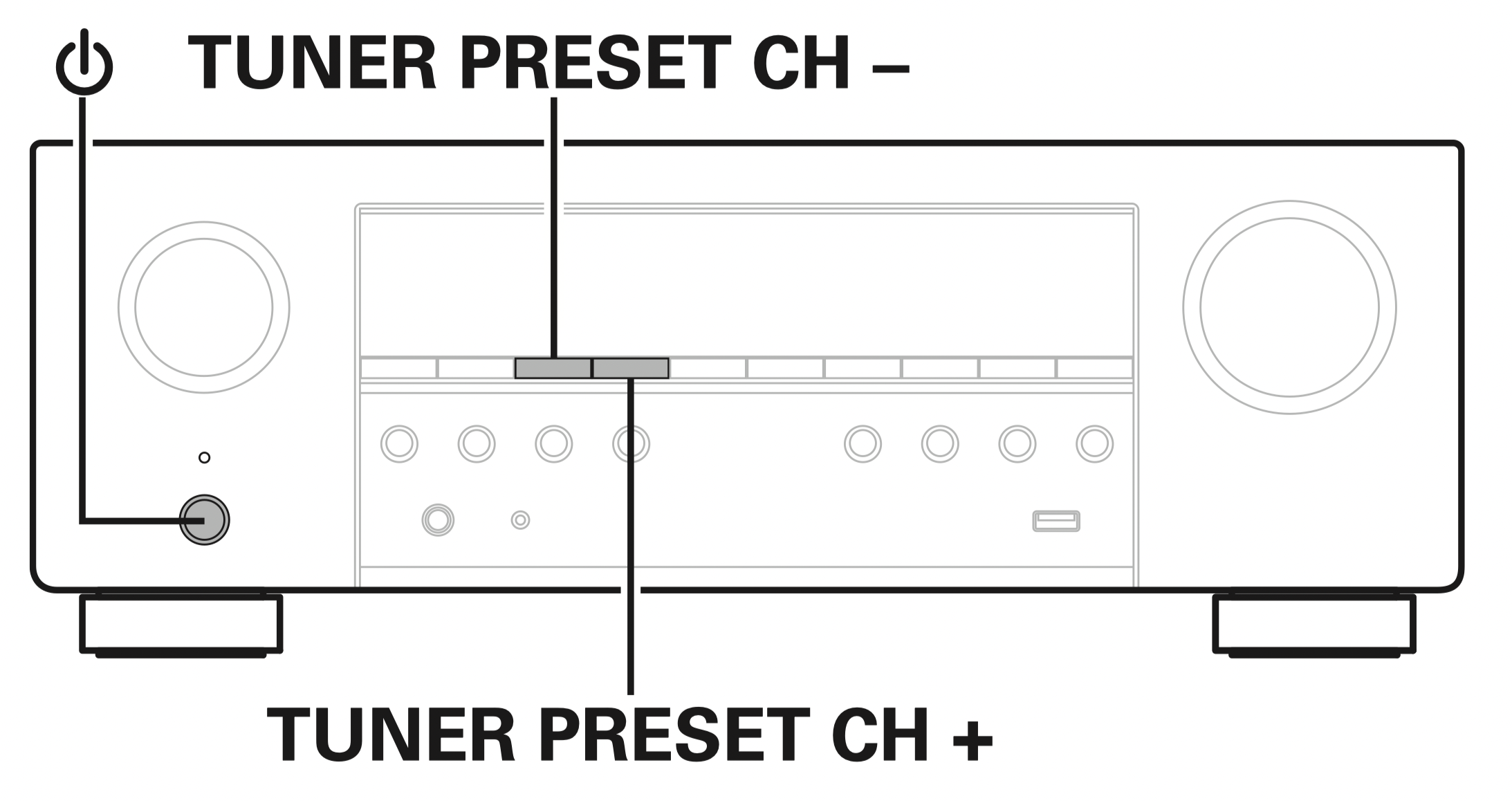
- Turn off the power using
 .
. - Press
 while simultaneously pressing TUNER PRESET CH + and TUNER PRESET CH –.
while simultaneously pressing TUNER PRESET CH + and TUNER PRESET CH –. - Remove your fingers from the two buttons when “Initialized” appears on the display.
NOTE:
- Before returning the settings to the default settings, use the “Save & Load” function from the menu to save and restore the details of various settings configured on the unit. (p. 213)
- You can also reset all settings to the factory defaults using “Reset” - “All Settings” in the menu. (p. 214)
Resetting network settings
If network contents cannot be played or the unit cannot connect to the network, restarting the unit may improve the problem. We recommend restarting the unit before returning the settings to the default settings. (p. 219)
If the operations are not improved by restarting the unit, follow the steps below.
Network settings are reset to the factory default values. Make settings again.
However, the menu “Amp Assign”, “Speaker Config.” and “Video” settings are not reset.
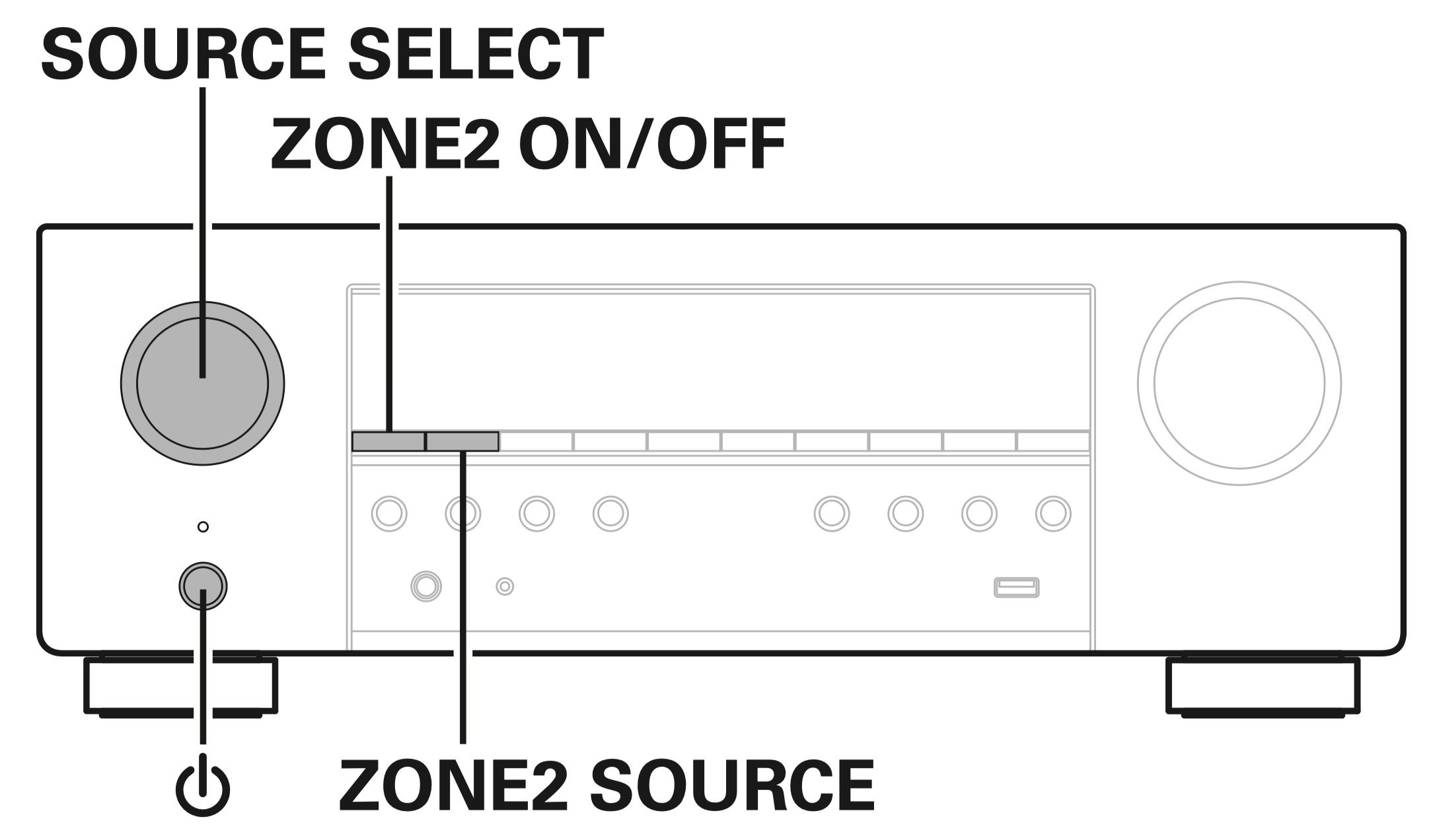
- Press
 to turn on power to the unit.
to turn on power to the unit. - Turn SOURCE SELECT to select “HEOS Music”.
- Press and hold the main unit's ZONE2 ON/OFF and ZONE2 SOURCE at the same time for at least 3 seconds.
- Remove your fingers from the two buttons when “Network Reset...” appears on the display.
- “Completed” is shown in the display when reset is complete.
NOTE:
- Before returning the settings to the default settings, use the “Save & Load” function from the menu to save and restore the details of various settings configured on the unit. (p. 213)
- You can also reset the network settings to the factory defaults using “Reset” “Network Settings” in the menu. (p. 214)
NOTE: Do not turn the power off until reset is complete.
Restoring the firmware to the factory defaults
When the unit or the network functions do not work properly, operation may be improved by restoring the firmware to the factory defaults.
Do this when the unit still does not work properly even after trying the steps for “Resetting factory settings” or “Resetting network settings”. (p. 238, 239)
After the firmware is restored, various settings are reset to the default settings. Configure the settings and update the firmware again.
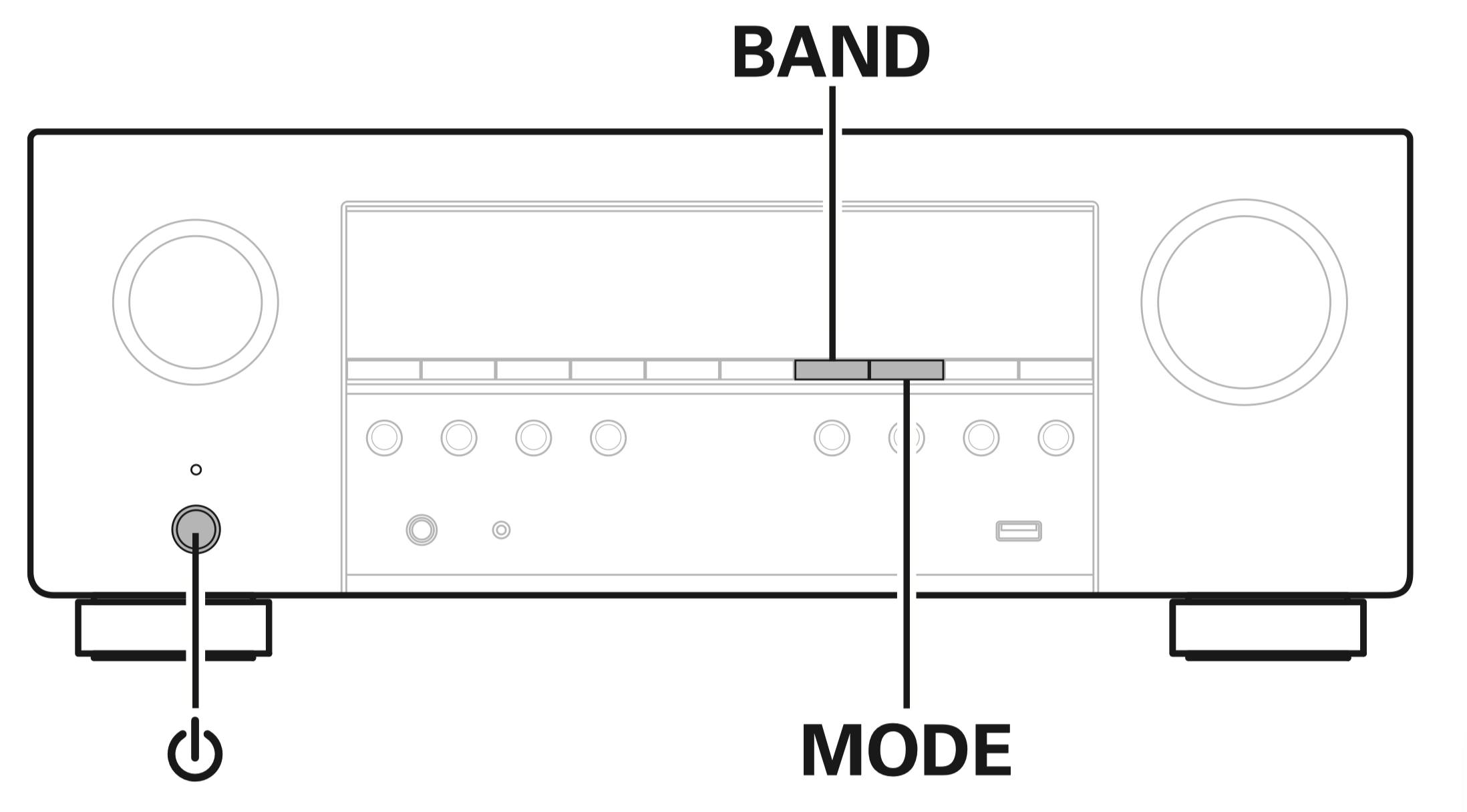
- Press
 while simultaneously pressing MODE and BAND.
while simultaneously pressing MODE and BAND. - When “Restoring FW...” appears on the display, release the buttons.
When the firmware restore is complete, “Completed” appears on the display for about 5 seconds, and the unit automatically restarts.
NOTE
- This operation takes time because it requires reconnecting to the network, restoring and updating the firmware.
- If this operation does not improve the problem, contact our customer service center.
NOTE: Do not turn off the power until the firmware restore is complete.
